Items
Tag is exactly
COVID-19
-
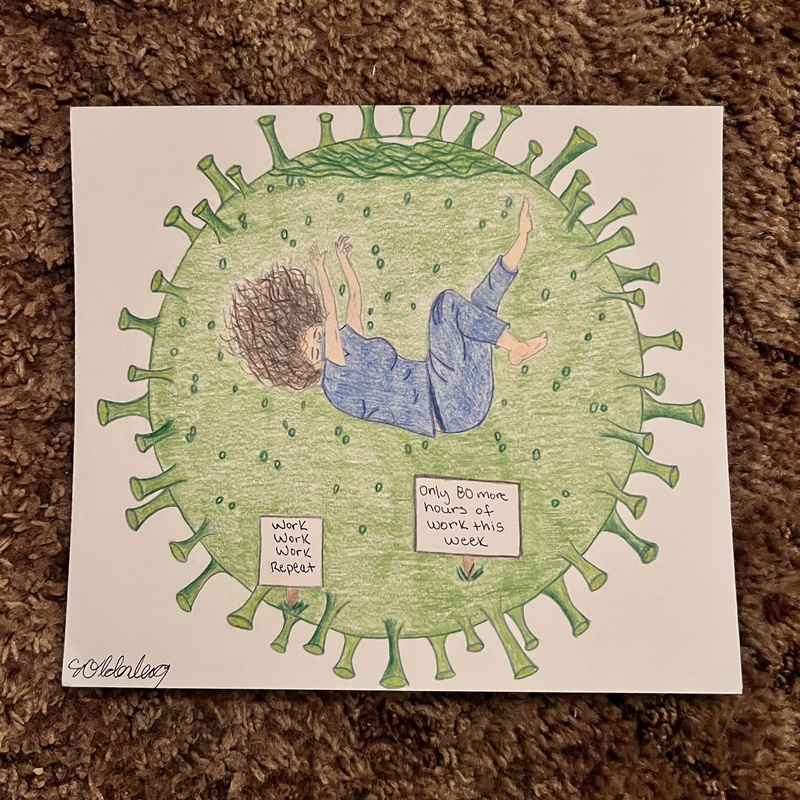 2022-02-23
2022-02-23Sinking into a Deep Sleep
I illustrated a CNA drowning in a molecule of sars-coV-19, also known as COVID19, to show the extreme conditions healthcare workers have been trying to push through during this pandemic. We have been working countless hours of overtime, sometimes for 24 or 48 hours straight due to understaffing, healthcare workers quitting, and others getting fired from refusing the vaccine. Our jobs have become very overwhelming, with the amount of cares we must provide for our patients, and with the thought of this pandemic having no end in sight, it's as if we're drowning in this pandemic. Healthcare workers are drowning in all the cares they must provide their patients, that they're unable to take care of themselves, and soon we won't have many healthcare and medical professionals left. That is why I chose to portray this CNA the way I did, and I hope others can agree with my experiences. -
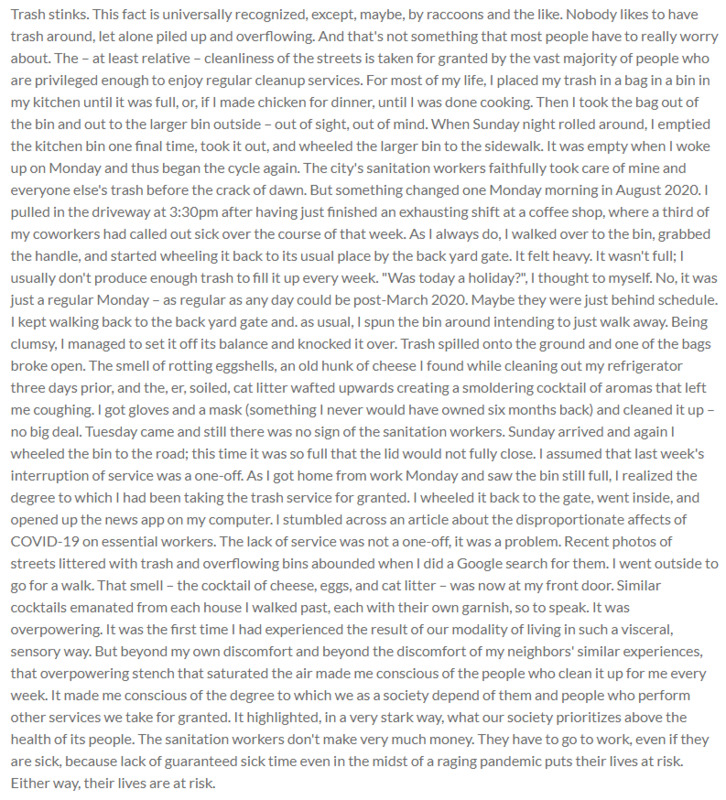 2020-08-10
2020-08-10Smelling the labor shortage
Trash stinks. This fact is universally recognized, except, maybe, by raccoons and the like. Nobody likes to have trash around, let alone piled up and overflowing. And that's not something that most people have to really worry about. The – at least relative – cleanliness of the streets is taken for granted by the vast majority of people who are privileged enough to enjoy regular cleanup services. For most of my life, I placed my trash in a bag in a bin in my kitchen until it was full, or, if I made chicken for dinner, until I was done cooking. Then I took the bag out of the bin and out to the larger bin outside – out of sight, out of mind. When Sunday night rolled around, I emptied the kitchen bin one final time, took it out, and wheeled the larger bin to the sidewalk. It was empty when I woke up on Monday and thus began the cycle again. The city's sanitation workers faithfully took care of mine and everyone else's trash before the crack of dawn. But something changed one Monday morning in August 2020. I pulled in the driveway at 3:30pm after having just finished an exhausting shift at a coffee shop, where a third of my coworkers had called out sick over the course of that week. As I always do, I walked over to the bin, grabbed the handle, and started wheeling it back to its usual place by the back yard gate. It felt heavy. It wasn't full; I usually don't produce enough trash to fill it up every week. "Was today a holiday?", I thought to myself. No, it was just a regular Monday – as regular as any day could be post-March 2020. Maybe they were just behind schedule. I kept walking back to the back yard gate and. as usual, I spun the bin around intending to just walk away. Being clumsy, I managed to set it off its balance and knocked it over. Trash spilled onto the ground and one of the bags broke open. The smell of rotting eggshells, an old hunk of cheese I found while cleaning out my refrigerator three days prior, and the, er, soiled, cat litter wafted upwards creating a smoldering cocktail of aromas that left me coughing. I got gloves and a mask (something I never would have owned six months back) and cleaned it up – no big deal. Tuesday came and still there was no sign of the sanitation workers. Sunday arrived and again I wheeled the bin to the road; this time it was so full that the lid would not fully close. I assumed that last week's interruption of service was a one-off. As I got home from work Monday and saw the bin still full, I realized the degree to which I had been taking the trash service for granted. I wheeled it back to the gate, went inside, and opened up the news app on my computer. I stumbled across an article about the disproportionate affects of COVID-19 on essential workers. The lack of service was not a one-off, it was a problem. Recent photos of streets littered with trash and overflowing bins abounded when I did a Google search for them. I went outside to go for a walk. That smell – the cocktail of cheese, eggs, and cat litter – was now at my front door. Similar cocktails emanated from each house I walked past, each with their own garnish, so to speak. It was overpowering. It was the first time I had experienced the result of our modality of living in such a visceral, sensory way. But beyond my own discomfort and beyond the discomfort of my neighbors' similar experiences, that overpowering stench that saturated the air made me conscious of the people who clean it up for me every week. It made me conscious of the degree to which we as a society depend of them and people who perform other services we take for granted. It highlighted, in a very stark way, what our society prioritizes above the health of its people. The sanitation workers don't make very much money. They have to go to work, even if they are sick, because lack of guaranteed sick time even in the midst of a raging pandemic puts their lives at risk. Either way, their lives are at risk. -
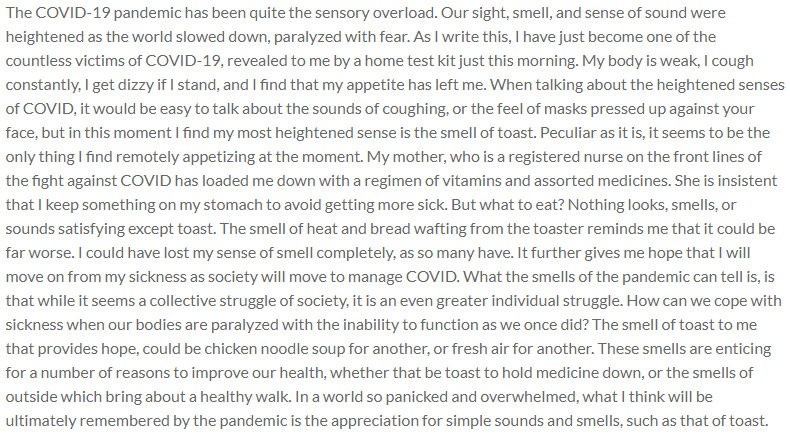 2022-02-01
2022-02-01The Toast of Covid
The COVID-19 pandemic has been quite the sensory overload. Our sight, smell, and sense of sound were heightened as the world slowed down, paralyzed with fear. As I write this, I have just become one of the countless victims of COVID-19, revealed to me by a home test kit just this morning. My body is weak, I cough constantly, I get dizzy if I stand, and I find that my appetite has left me. When talking about the heightened senses of COVID, it would be easy to talk about the sounds of coughing, or the feel of masks pressed up against your face, but in this moment I find my most heightened sense is the smell of toast. Peculiar as it is, it seems to be the only thing I find remotely appetizing at the moment. My mother, who is a registered nurse on the front lines of the fight against COVID has loaded me down with a regimen of vitamins and assorted medicines. She is insistent that I keep something on my stomach to avoid getting more sick. But what to eat? Nothing looks, smells, or sounds satisfying except toast. The smell of heat and bread wafting from the toaster reminds me that it could be far worse. I could have lost my sense of smell completely, as so many have. It further gives me hope that I will move on from my sickness as society will move to manage COVID. What the smells of the pandemic can tell is, is that while it seems a collective struggle of society, it is an even greater individual struggle. How can we cope with sickness when our bodies are paralyzed with the inability to function as we once did? The smell of toast to me that provides hope, could be chicken noodle soup for another, or fresh air for another. These smells are enticing for a number of reasons to improve our health, whether that be toast to hold medicine down, or the smells of outside which bring about a healthy walk. In a world so panicked and overwhelmed, what I think will be ultimately remembered by the pandemic is the appreciation for simple sounds and smells, such as that of toast. -
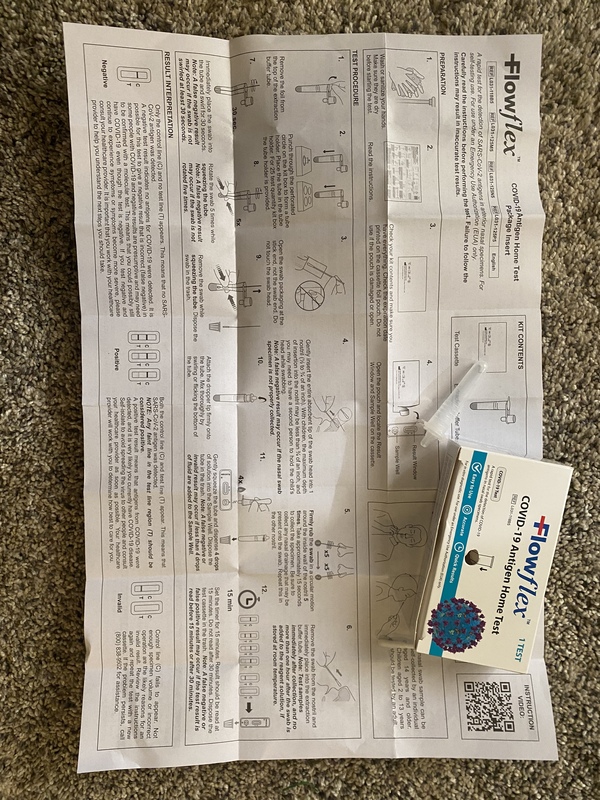 2022-01-03
2022-01-03It finally happened
We’re two months short of the two year anniversary of the Covid outbreak here in the US. My family of four followed the rules, masked up, quarantined and my husband and I were vaccinated as soon as we were able. This holiday season we found ourselves living life as we had before Covid, we got too comfortable. Our children are small and we were still unsure if we wanted to get our six year old vaccinated. We went into public spaces unvaccinated, participated in all the family Christmas festivities and then we got sick. I thought it was a cold at first and then one day it dawned on me that my sense of smell and taste were gone. Then the guilt and shame set in. We got too comfortable, we lost sight of the fact that Covid is not gone. People are still dying. My husband and I are fine, it’s like a cold with the added adventure of not being able to taste anything. I worry for my kids though. I feel guilty that we didn’t get my oldest vaccinated. I hate to watch her fight this with only over the counter medication to help her. I feel for my three year old. I hope they don’t get worse. This was a rude awakening for us all, Covid is not gone. -
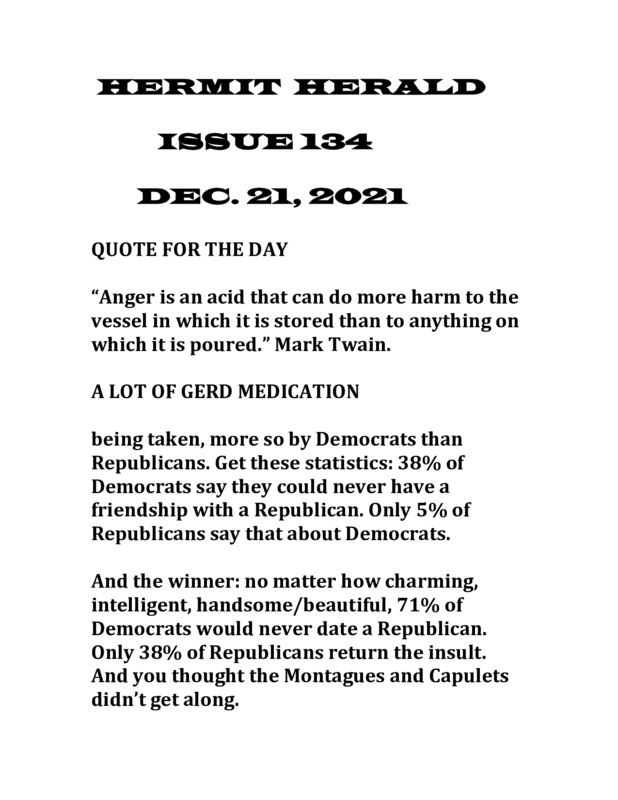 2021-12-21
2021-12-21HERMIT HERALD, ISSUE 134
Anger devours the angry -
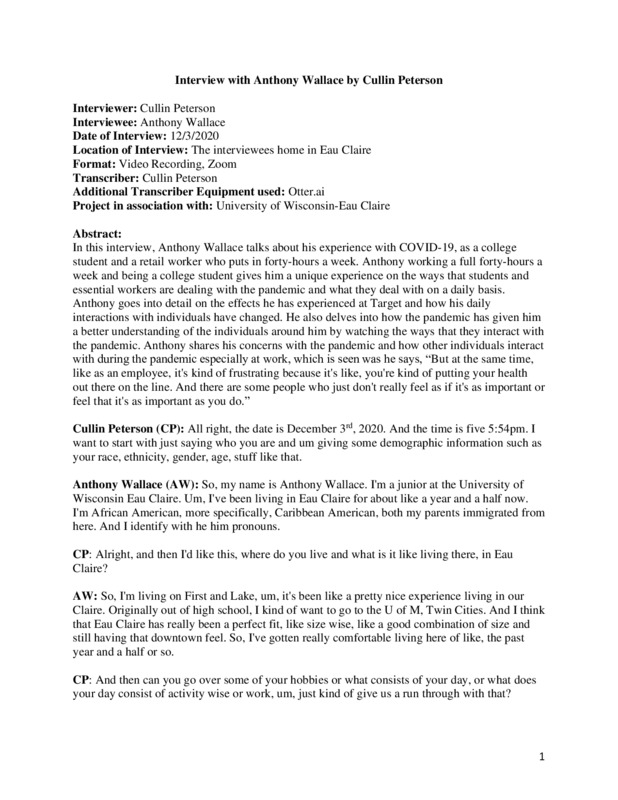 12/11/2020
12/11/2020Anthony Wallace Oral History, 2020/12/11
C19OH -
2020-03-13
The Banquet
It was my junior year of high school and a Thursday night in March at DePaul College Prep. My bowling team boys and girls had gathered for our annual end of season banquet, a last hurrah. We had fun; ate pizza together, talked about memories made during the season and more. At the end we started to talk about how 50 kids had called out of school that day not including teachers and how crazy the flu was this year. It wasn't the flu, but we didn't know that it would be our last time at school for the year and seeing each other in general. My boyfriend who played baseball was talking to the bowling and baseball coach about the Nashville trip the team was going take over spring break the next week, the coach said it might get cancelled. This was due to the way COVID was effecting it people down there, we laughed it off and said whatever its just the flu, it wasn't the flu. He got the email it was cancelled that night and the following night we got the email school was shutting down for an extra week after spring break. Yay we said "an extra week of break" but it wasn't just a week its months and still going. -
2020-03-30
Having to wear masks
The news article I put is an article about having to wear masks through the pandemic. This was a big change for America with many people wearing masks to help slow the spread and keep ourselves and those around us safe from covid. Many states had laws on when to wear masks, this was a historic moment for America when they announced we had to wear masks because the covid illness is very serious. -
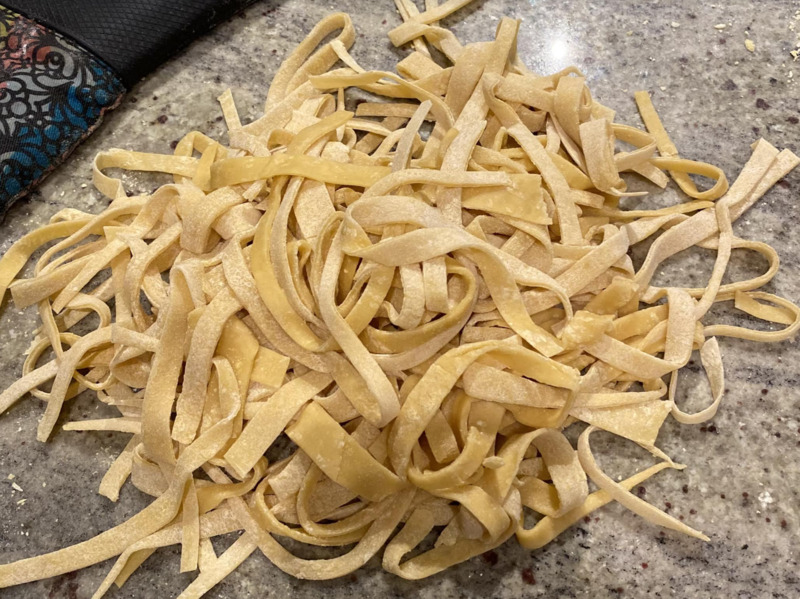 2021-12-17
2021-12-17Cooking During Covid
These photos are a couple of many foods I have created during the Covid-19 pandemic. Although these times were depressing and lonely in ways it was a gift for me to be given the time to find my passion as a chef. Homemade pasta takes 2+ hours, and homemade bread takes 4+ I never would have had the time to do this before Covid. I think that during this time it is very important to find a little bit of light in a time of darkness, and that's what I did. -
 2021-12-16
2021-12-16Asian Lives Matter
When I went to summer camp, I spoke Chinese to my friends who could not speak english very well. However, we were constantly told that "this is America" and we needed to speak english so everyone could understand and didn't feel left out. -
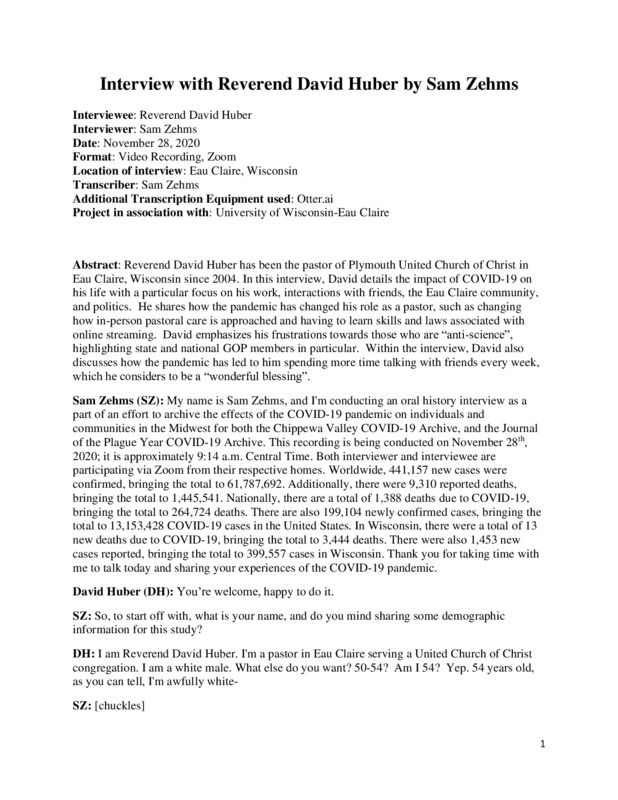 12/15/2020
12/15/2020David Huber Oral History, 2020/12/15
C19OH -
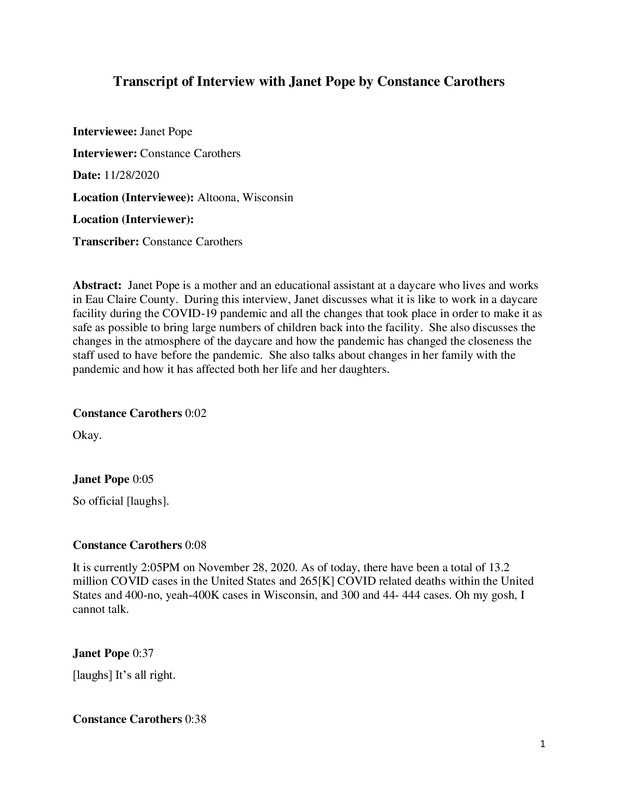 12/11/2020
12/11/2020Janet Pope Oral History, 2020/12/11
C19OH -
 2021-05-24
2021-05-24A Glimpse of Masked Goodbyes
Ever since I was a kid, I waited for the day I would get to walk across the stage inside a huge stadium to receive my diploma, with my family and friends watching. That day did not turn out quite as expected. My senior year began in August of 2020, during the height of COVID. No one knew when or if we would be going back to school in person. We lost football games, homecoming, the senior trip, and almost two semesters of getting to spend time in class with friends. We missed out on finally being a senior. All we could hope for was to be able to have more than a drive-thru graduation. Our class was lucky enough to be able to go back to school for a few months and we got to have an in-person graduation on the football field. Even though there were only just under 200 students per day over the course of our 4-day graduation ceremonies, it was definitely an experience I will never forget. I was grateful that I got to walk across that stage with my family watching. I was grateful that I got to watch my friends who I have known for years, and with who I began this journey, get their diplomas as well. This photo encapsulates the moment that we had officially graduated. As we went in for a masked-up embrace, I thought about so much I had to go through to get to that moment. All of the highs, lows, long nights up studying, fun school events, losing friends who were near and dear to my heart, and making it through what is supposed to be the best year of high school during a worldwide pandemic. It was a bittersweet moment, marking the end of one journey, but the start of the next. I do not know what the future holds, but I hope to never have to experience more masked goodbyes. -
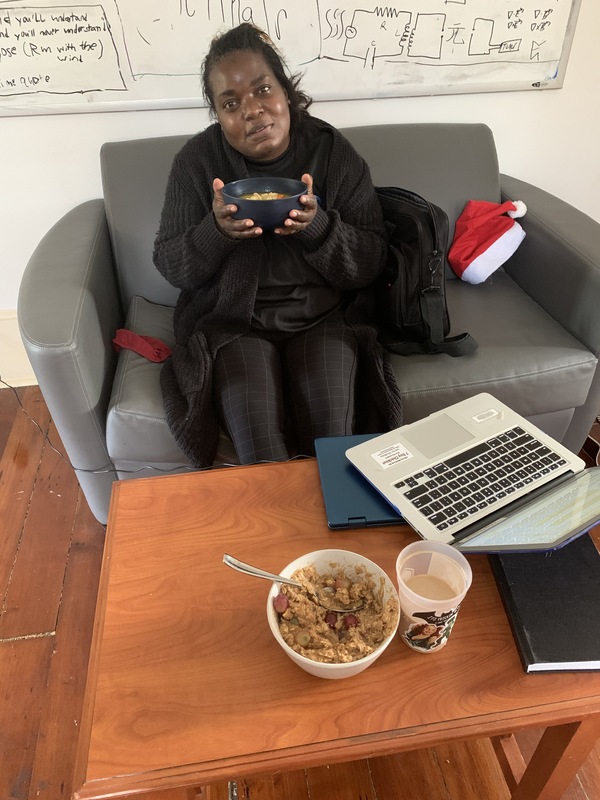 2020-02-21
2020-02-21Journey into Georgetta's Covid Experience
My name is Georgetta Jones, and I am a cashier at the College of Charleston City Bistro. Also, I work at a Daycare; Devine Daycare. As soon as Covid-19 started, I contracted it (February 2020) due to my being an 'essential worker' at my job. I was horribly laid up for fourteen days, and, as this was before the vaccines were released, I was afraid & certain I was going to die from this terrible disease. Fortunately, due to my rare blood type (O+), I had natural immunity to the virus, and was able to recover quickly after the fourteenth day; I went back to work on the 15th day. COVID-19 is a horrible virus, & it is shameful not to see people take it seriously. Due to my vitamins & water, I was able to get better quickly; it is important to take the natural precautions to protect oneself against the disease. If we as a country (and the world) are to overcome this deadly disease, we must trust in medicine, trust the doctors, trust science, and, most importantly, trust each other. -
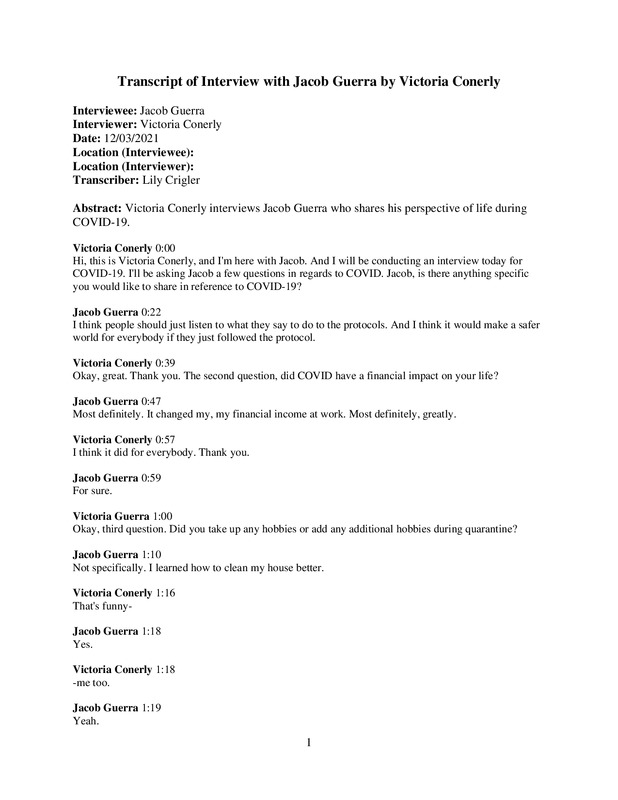 2021-12-03
2021-12-03Jacob Guerra Oral History, 2021/12/03
I conducted an interview with Jacob Guerra. It was my pleasure listening to his perspective and learning more about his insight in reference to COVID 19. -
 2021-12-03
2021-12-03Juliana Marston and Sydney Champagne Oral History, 2021/12/03
We are both students in college. In our History of Pandemics class, we learned about past pandemics (namely the Bubonic Plague, Smallpox, Cholera, and Influenza pandemics) and how they impacted society. This course also challenged us to compare and contrast the current pandemic to those of the past, while considering how mankind may fare in pandemics moving forward. We discuss these things and more in the interview recording. -
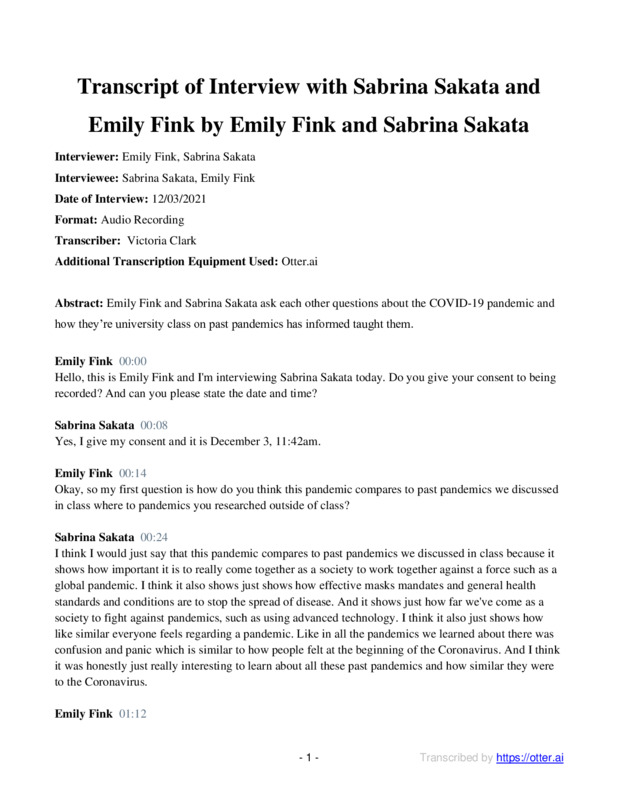 2021-12-03
2021-12-03Sabrina Sakata and Emily Fink Oral History, 2021/12/03
how past pandemics relate to the current COVID-19 pandemic -
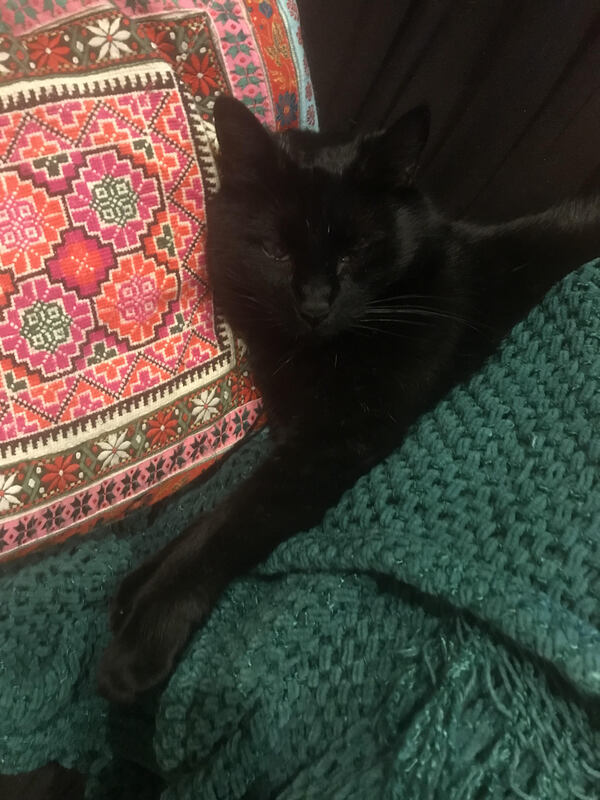 2021-10-01
2021-10-01My Breakthrough COVID-19 Case
October 1, 2021, I woke up with a mild headache and a stuffy nose. I didn't think much of it—I had started drinking coffee again and needed a cup, and I’m mildly allergic to my own cats. My headache went away after I had my coffee, and my congestion ceased after I took my Claritin. After working remotely and basically not socializing for all of 2020 and up through August 2021, I was happy to be out and doing things again. In August, I started working and attending class in-person again, as well as spending time with friends. I still masked up and washed my hands according to guidelines, but it did seem like standards for that were slipping. I take public transit most days, and I’d seen a number of people who either weren’t wearing masks or not wearing them properly. But I still thought I was fairly safe since I followed COVID-19 recommendations, was fully vaccinated, and my campus has an extremely high vaccination rate (100% of students are vaccinated or have exemptions, and 98% of faculty/staff). So when I woke up experiencing what I thought were symptoms of seasonal allergies, I didn’t think anything of it. I went on a date that afternoon, and then out for drinks with friends later that night. I was very tired when I went home that night, but I chalked it up to how I’d over-committed myself in the initial euphoria of being able to participate in things again. Besides, I was sleeping better than I’d slept in years. The next day, my congestion was worse and I was coughing. I had an intermittent headache, but I assumed it was just a cold. One of my classmates that I sit next to had had one recently, and she’d tested negative for COVID, so I just assumed I’d picked it up from her. I remained congested and feeling gross that weekend, enough to call out from my shift on Sunday out of an abundance of caution, but I figured I’d be ready to be back by the time I had class and work again on Wednesday. But Monday afternoon I was working on some of my reading and realized I couldn’t smell the new (and very strong) candle in my living room. To test whether it was just the candle or whether it was me, I sniffed my perfume and finally even put peppermint essential oil right under my nose, and...nothing. Figuring that it was likely I had COVID at this point, I scheduled a test for the next day. I felt bad about having to get there—was it better to take an Uber or a train/bus? Which was safer for everyone involved? I ended up taking a Lyft, but I left the windows down and made sure I had cough drops so I wouldn’t cough. Once I arrived at the testing center (where I was the only patient), they got me through quickly and told me they’d be doing PCR testing and I could expect my results within a couple days. I called out of work for the week and let my professors know I likely had it. I woke up on Thursday morning to see my results had arrived, and I had tested positive. I called my school for contact tracing, and they notified the classmates I sit next to and my coworkers. I texted my friends I’d been out with Friday night and the person I went out with, and it was strange to feel almost ashamed. I had behaved responsibly, but I still felt as though I’d done something wrong in contracting COVID. And I was exhausted, tired of coughing, and just wanted my mom. I continued to improve, and I felt mostly better by the time my isolation period ended on the 11th. My sense of smell had started to come back, so I wasn’t as worried about a permanent loss there. I was a little concerned by the disregard for no-contact delivery I’d requested when getting food/groceries, but it had mostly been okay. My shifts at work had been given away, even though I was better and out of isolation by then. On the bright side, my cats were thrilled to have had me home that much, so at least it was a good experience for someone. Everyone I notified directly or via contact tracing tested negative, fortunately. When I started going back to things, I just wanted to scream on the train when I saw people not wearing masks or wearing them improperly. I still do, especially as the number of cases rises. -
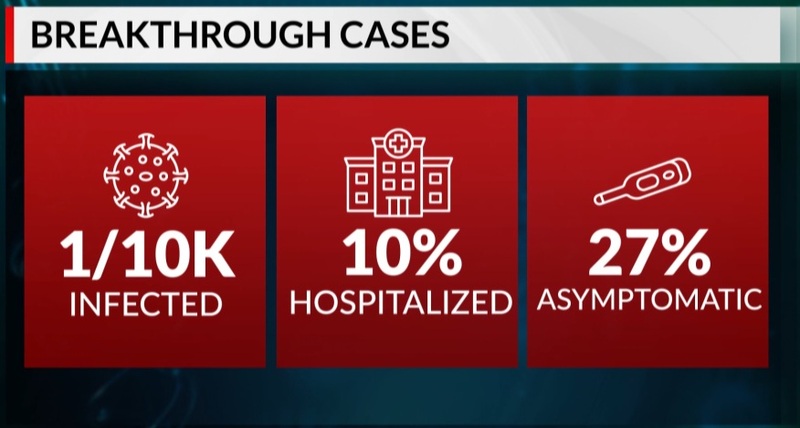 2021-05-25
2021-05-25Breakthrough COVID-19 cases possible but rarity shows vaccine effectiveness
This graphic shows the rates of infection and hospitalization for breakthrough infections for COVID-19 among vaccinated people (as of May 2021) -
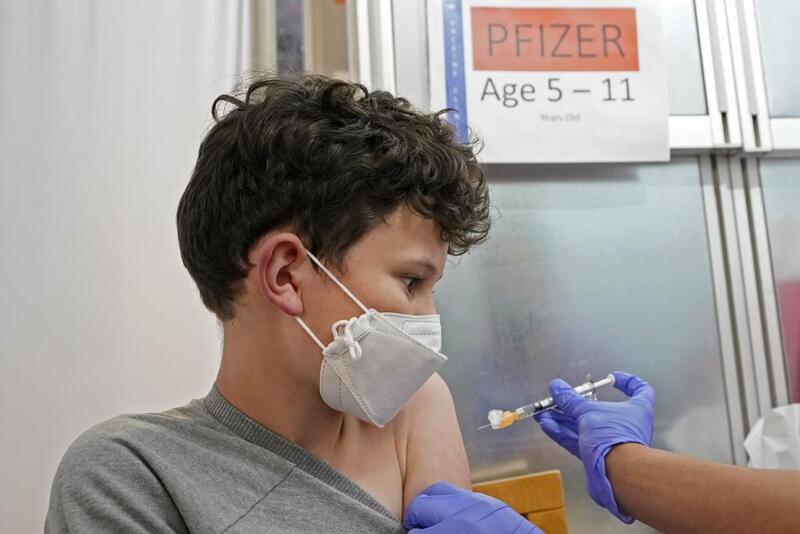 2021-11-10
2021-11-10Children Ages 5-11 Now Eligible for Vaccine
The campaign to vaccinate elementary school age children in the U.S. is off to a strong start, health officials said Wednesday, but experts say there are signs that it will be difficult to sustain the initial momentum. About 900,000 kids aged 5 to 11 will have received their first dose of the COVID-19 vaccine in their first week of eligibility, the White House said, providing the first glimpse at the pace of the school-aged vaccination campaign. “We’re off to a very strong start,” said White House COVID-19 coordinator Jeff Zients, during a briefing with reporters. Final clearance for the shots was granted by federal regulators on Nov. 2, with the first doses to kids beginning in some locations the following day. The estimated increase in vaccinations in elementary school age children appears similar to a jump seen in May, when adolescents ages 12 to 15 became eligible for shots. Now nearly 20,000 pharmacies, clinics and physicians’ offices are offering the doses to younger kids, and the Biden administration estimates that by the end of Wednesday more than 900,000 of the kid doses will have been given. On top of that, about 700,000 first-shot appointments are scheduled for the coming days. About 28 million 5 to 11 year-olds are now eligible for the low-dose Pfizer vaccine. Kids who get their first of two shots by the end of next week will be fully vaccinated by Christmas. The administration is encouraging schools to host vaccine clinics on site to make it even easier for kids to get shots. The White House is also asking schools to share information from “trusted messengers” like doctors and public health officials to combat misinformation around the vaccines. A initial surge in demand for vaccinations was expected from parents who have been waiting for the chance to protect their younger kids, especially before the holidays. About 3% of newly eligible children in the U.S. got first shots in the first week, but the rate of vaccinations in varied widely around the country, as it has for adult vaccines. California Health and Human Services Secretary Dr. Mark Ghaly said Wednesday that more than 110,000 Californians ages 5 to 11 have received their first coronavirus shot — 9% of kids that age in the state. “We are starting to see this pick up and I’m really encouraged about what this means for our state,” Ghaly said. On the other ends of the spectrum, Idaho reported just 2,257 first shots, or 1.3% of the newly eligible kids there. In West Virginia’s Cabell County, high demand led local health officials to start setting up vaccination clinics in all the county’s public middle schools. A spokeswoman for the county health department said there were some lines for vaccines in the first few days after the doses were approved for kids ages 5 to 11, but that things have slowed since then. Some experts say that nationally, demand could also begin to recede soon. They note polling data suggests only a fraction of parents have planned to get their kids shots immediately, and they suspect the trend will play out like it did earlier this year when kids ages 12 to 15 were first able to get shots. In the first week after vaccines for that age group were authorized in May, the number of adolescents getting a first shot jumped by roughly 900,000, according to an American Academy of Pediatrics review of federal data. The next week, it rose even further, to 1.6 million. “There was an initial burst,” said Shannon Stokley of the Centers for Disease Control and Prevention. But then the number dropped steadily for months, interrupted only briefly in early August as the delta variant surged and parents prepared to send children back to school. Adolescent vaccinations have since flagged considerably, to just 32,000 getting their first shots last week. Only about half of adolescents ages 12 to 17 are fully vaccinated, compared to 70% of adults. It’s unlikely that vaccination rates in young kids will be as high as what’s seen in adults — or even in adolescents, some experts said, unless they are required for school. Part of the reason is that adults are far more likely than children to suffer serious illness or die from COVID-19, they noted. “Parents may have the perception it may not be as serious in young children or they don’t transmit it,” said Stokley, the acting deputy director of the CDC’s Immunization Services Division. But more than 2 million COVID cases have been reported in U.S. children ages 5 to 11 since the pandemic started, including 66 deaths over the past year, according to CDC data. “We’re going to have a lot of work to do to communicate to parents about why it’s important to get children vaccinated,” she said. Zients said the effort to vaccinate younger kids is still ramping up, with new clinics coming on line. Government officials expect the number of children who are vaccinated to keep rising in the days and weeks ahead, he said. “We are just getting started,” he said. Earlier this year the White House set — and missed — a July 4 goal to have at least certain percentage of U.S. adults vaccinated. Officials have not announced a similar target for kids. Dr. Lee Savio Beers, president of the American Academy of Pediatrics, called the new numbers reassuring and said the rollout appears to be going smoothly for the most part. She noted however that with a lower dose and different vials than for older kids, the rollout requires more steps and that some states have been slower in getting vaccine to providers. Initial data from some areas show Black children lagging behind whites in getting their first doses, which Beers said raises concerns. “It’s really important to make sure the vaccine is easily accessible in a wide variety of places,” Beers said. -
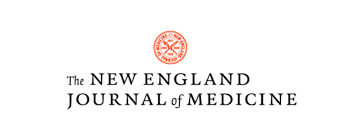 2021-09-16
2021-09-16The Importance of Context in Covid-19 Vaccine Safety
Vaccine safety is critical for the successful implementation of any vaccination program, especially during a pandemic. In February 1976, the Centers for Disease Control and Prevention confirmed a cluster of cases of severe influenza-like illness among Army recruits at Fort Dix, New Jersey.1 A swine influenza A strain that resembled the 1918 pandemic influenza strain was identified,2 and a vaccination program was subsequently initiated for the entire U.S. population. After more than 40 million persons were vaccinated, a small excess risk of Guillain–Barré syndrome was noted, with an attributable risk of approximately 1 case per 100,000 doses administered. Given these concerns and because the pandemic did not materialize, the vaccination program was halted in December 1976 so that the issue could be explored further. This experience shed light on the need for real-time vaccine safety surveillance and the importance of context in decision making during a pandemic. In a study now reported in the Journal by Barda et al., the investigators simultaneously evaluated the risk of adverse events among persons (≥16 years of age) who had received the BNT162b2 vaccine (Pfizer–BioNTech) and the risk of the same events after severe acute respiratory syndrome coronavirus 2 (SARS-CoV-2) infection.3 The authors used data from the largest integrated payer–provider health care organization in Israel, in conjunction with data on SARS-CoV-2 polymerase-chain-reaction tests and data on coronavirus disease 2019 (Covid-19) vaccine administration from the Israeli Ministry of Health. This use of multiple data sets highlights the importance of investment in digital capabilities and meaningful integration across systems in order to provide real-time answers to key public health questions. The design of rigorous postauthorization vaccine safety studies during the Covid-19 pandemic has been a challenge because the pandemic itself has caused changes in health care utilization, the rollout of Covid-19 vaccines has occurred in phases because of initial supply limitations, and there have been disparities in access to vaccines. Barda et al. broadly addressed many of these challenges by emulating a trial that matched eligible vaccinees to unvaccinated controls according to sociodemographic characteristics, the number of preexisting chronic health conditions, previous health care utilization, and pregnancy status. In the vaccination analysis, the study included 42 days of follow-up (i.e., 21 days after the first dose and 21 days after the second dose). This analysis accounted for seasonal and secular trends by matching on the day of vaccination, rather than relying on historical risk estimates that may not have been comparable in the pandemic setting. In the SARS-CoV-2 analysis, a similar approach was used to match persons with a newly diagnosed infection to uninfected persons. Although the risk estimates in the vaccination and the SARS-CoV-2 analyses were not directly comparable because of differences in the populations (i.e., events were evaluated per 100,000 vaccinated persons and per 100,000 infected persons, respectively), these risks were placed in context. The most salient example is myocarditis, which has received much attention recently given the preponderance of reported cases after vaccination among adolescents and young adults and the incidence of myocarditis observed after SARS-CoV-2 infection.4-6 In the population-based cohort in the study conducted by Barda and colleagues, the risk ratios for myocarditis were 3.24 (95% confidence interval [CI], 1.55 to 12.44) after vaccination and 18.28 (95% CI, 3.95 to 25.12) after SARS-CoV-2 infection, with risk differences of 2.7 events per 100,000 persons (95% CI, 1.0 to 4.6) and 11.0 events per 100,000 persons (95% CI, 5.6 to 15.8), respectively. What is even more compelling about these data is the substantial protective effect of vaccines with respect to adverse events such as acute kidney injury, intracranial hemorrhage, and anemia, probably because infection was prevented. Furthermore, the persons with SARS-CoV-2 infection appeared to be at substantially higher risk for arrhythmia, myocardial infarction, deep-vein thrombosis, pulmonary embolism, pericarditis, intracerebral hemorrhage, and thrombocytopenia than those who received the BNT162b2 vaccine. National discussions about benefit–risk balance often focus on the benefits of preventing symptomatic disease, hospitalization, or death due to Covid-19 and the risks of serious adverse events after vaccination.7,8 As specific adverse events such as myocarditis are highlighted, however, the lack of corresponding specificity about benefits can hamper efforts to communicate effectively with patients. Messenger RNA (mRNA) vaccines may be associated with myocarditis, but they can also prevent cases of myocarditis, acute kidney injury, arrhythmia, and thromboembolic disease. The key to comparing these risks depends on the risk of SARS-CoV-2 infection to an individual person, and that risk can vary according to place and over time. Given the current state of the global pandemic, however, the risk of exposure to SARS-CoV-2 appears to be inevitable. One major limitation of this study is the lack of risk estimates according to age group and sex. For example, thrombosis with thrombocytopenia syndrome occurs predominantly in young adult women who have received adenoviral vector vaccines against SARS-CoV-2, whereas myocarditis predominantly occurs in male teens and young men who have received mRNA vaccines.5,9,10 Age- and sex-stratified comparisons that reflect local epidemiologic factors might support public understanding of different approaches to vaccine use in different countries, such as Israel, the United Kingdom, and the United States. Other limitations of the study include the paucity of data regarding younger teens and children, the conservative assumption that vaccines have no effect on transmission, and the absence of medical record review to validate computable phenotypes (i.e., algorithms used to identify a cohort on the basis of patient records). As new knowledge of the safety and benefits of vaccines continues to evolve, studies like this one may help to support decision making about the use of Covid-19 vaccines. The benefit–risk balance should be reassessed, refined, and communicated as the disease burden changes, new variants and safety signals emerge, and vaccine effectiveness begins to wane. Context matters, which means that we as a country need to be ready for continual learning and change. -
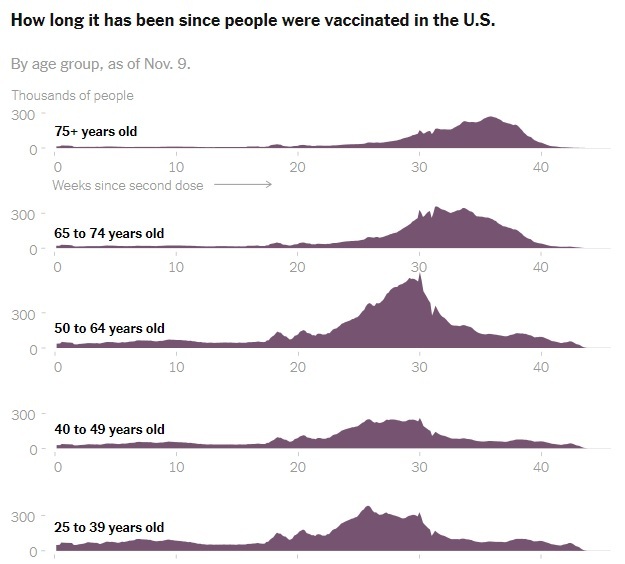 2021-11-11
2021-11-11What We Know So Far About Waning Vaccine Effectiveness
As tens of millions who are eligible in the United States consider signing up for a Covid-19 booster shot, a growing body of early global research shows that the vaccines authorized in the United States remain highly protective against the disease’s worst outcomes over time, with some exceptions among older people and those with weakened immune systems. But while the vaccines’ effectiveness against severe disease and hospitalization has mostly held steady, even through the summer surge of the highly transmissible Delta variant, a number of published studies show that their protection against infection, with or without symptoms, has fallen. Public health experts say this decline does not mean that the vaccines are not working. In fact, many studies show that the vaccines remain more than 50 percent effective at preventing infection, the level that all Covid vaccines had to meet or exceed to be authorized by the Food and Drug Administration back in 2020. But the significance of these declines in effectiveness — and whether they suggest all adults should be eligible for a booster shot — is still up for debate. -
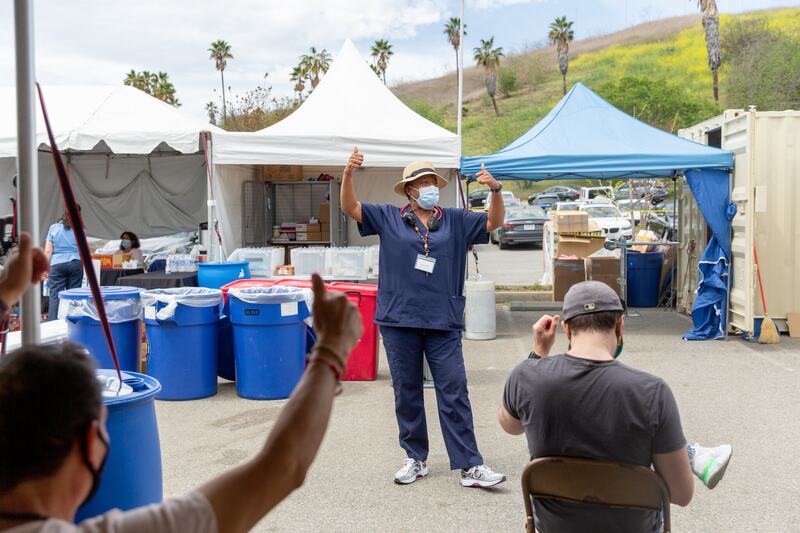 2021-04-06
2021-04-06Biden will offer a virus update as the pace of vaccination accelerates
President Biden will promote his administration’s success in accelerating the pace of coronavirus vaccinations during two appearances on Tuesday, as officials in nearly every state say they will make shots available to all adults by his target of April 19. Three months into his presidency, Mr. Biden confronts an escalating migrant surge at the border with Mexico and has embarked on a grind-it-out effort to ram through a $2.3 trillion infrastructure bill. But the virus remains his primary focus. And he wants the country to know that — so he is offering multiple updates each week, along with helpful visual cues, like standing next to a giant Easter bunny wearing a mask. On Tuesday afternoon, Mr. Biden will travel to Alexandria, Va., to tour a vaccination site at the Virginia Theological Seminary. Later, at the White House, he will deliver remarks emphasizing recent successes, including the milestone of delivering four million vaccinations in one day over the weekend. More than three million doses are now being given on average each day, compared with well under one million when Mr. Biden took office in January, according to the Centers for Disease Control and Prevention. Every state has now given at least one dose to a quarter or more of its population. About 62.4 million people — 19 percent of Americans — have been fully vaccinated. On Monday, Gov. Larry Hogan of Maryland announced that all Maryland residents 16 or older would be eligible from Tuesday for a shot at the state’s mass vaccination sites, and starting April 19 at any vaccine provider in the state. Also on Monday, Gov. Philip D. Murphy of New Jersey and Mayor Muriel Bowser of Washington, D.C., said residents 16 or older would be eligible on April 19. Gov. Kate Brown of Oregon announced Tuesday that all Oregonians over the age of 16 were eligible to receive a vaccine. The state had been limiting the doses to those with underlying conditions and frontline workers. That leaves one state, Hawaii, keeping to Mr. Biden’s original deadline of May 1. In Hawaii, 34 percent of residents have received at least one dose. Alabama has vaccinated the lowest proportion of its residents, at 25 percent. Along with dangerous coronavirus variants that were identified in Britain, South Africa and Brazil, new mutations have continued to pop up in the United States, from California to New York to Oregon. The shots will eventually win, scientists say, but because each infection gives the coronavirus a chance to evolve further, vaccinations must proceed as quickly as possible. For now, however, cases are rising sharply in parts of the country, with some states offering a stark reminder that the pandemic is far from over. Yet again, governors across the country have lifted precautions like mask mandates and capacity limits on businesses. -
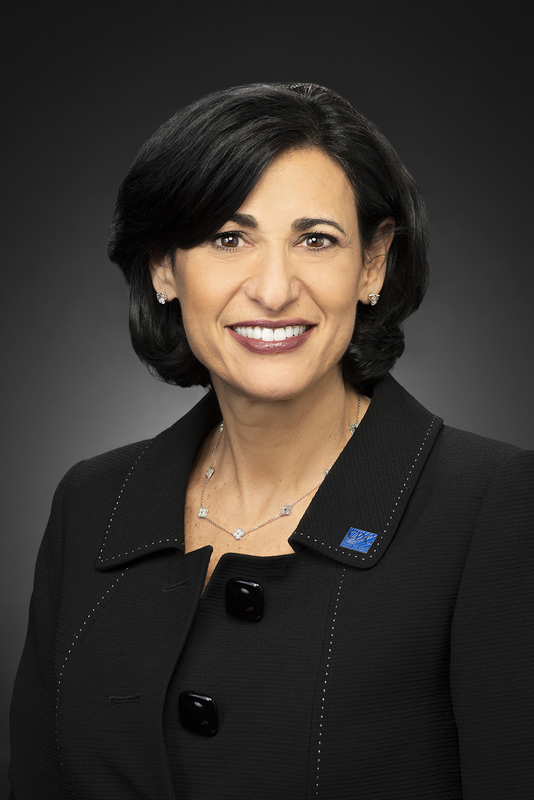 2021-01-19
2021-01-19Incoming CDC Director to Prioritize Communication, COVID-19 Vaccine Rollout
As Rochelle Walensky, MD, MPH, prepares to assume the role of CDC director on January 20, the former professor of medicine at Harvard Medical School and infectious disease physician at Massachusetts General Hospital and Brigham Women’s Hospital faces a myriad of challenges wrought by the ongoing coronavirus disease 2019 (COVID-19) pandemic. January 21st marks the 1-year mark since the first case of COVID-19 was reported in the United States, while current data indicate the country has surpassed 400,000 deaths. In comparison, the 1918 flu pandemic took 675,000 American lives, while the US reported a total of 405,000 fatalities during World War II. Even at the unprecedented speed with which pharmaceutical companies have developed vaccines for COVID-19, rollout has been fragmented at the state level while racial disparities in administration rates are beginning to become apparent. In an effort to improve the national rollout of COVID-19 vaccines, Walensky plans to increase the CDC’s communication to combat any hesitancy in receiving the vaccine, and indicated she wanted to increase media appearances above those made by current director Robert Redfield, MD, who departs with any remaining Trump administration officials Wednesday. She said making sure science-based communication is effectively disseminated to the public in layman’s terms is a top priority. “Science is now conveyed through Twitter. Science is conveyed on social media, on podcasts, and in many different ways. And I think that's critical,” Walensky said during a livestreamed interview with JAMA's Howard Bauchner, MD, the journal's editor-in-chief. When confronting vaccine hesitancy or anti-vaxxer sentiment on social media, “There's just this massive void and the right information, I think, is not getting out there… I want to make sure that the science is conveyed. We have to say it to one another. We have to say it to the public. And then we have to say it in other forms.” Internally, Walensky hopes to bolster the voices of scientists already employed by the CDC. Under the Trump presidency, “they have been diminished. I think they've been muzzled,” Walensky said. “This top tier agency—world renowned—hasn't really been appreciated over the last 4 years, and really markedly over the last year. So I have to fix that.” Although some states have been widely successful in administering the allotment of COVID-19 vaccines they were given, many have reported roadblocks. Part of the Biden administration’s plan to enhance rollout is to expand vaccine allocation to 4 key locations: federally qualified health centers, community vaccination centers (ie, stadiums), mobile units, and pharmacies. “Part of the challenge with COVID-19 was that we had a frail public health infrastructure to start. It wasn't ready to tackle what it was given,” Walensky said. As director, she hopes to bring this reality to Congress’ attention. “We're in this because we had warnings for many, many other public health scares in the last 20 years and we didn't fix our public health infrastructure and our data infrastructure,” in response to those tests. In order to meet President-elect Biden’s goal of 100 million vaccinations in 100 days, the constraints currently faced by federal and state governments need to be mitigated. “We have to titrate our supply and our eligibility so that we somehow hit the sweet spot, wherever it is we are, with how much supply we have and how many people are eligible,” Walensky said. While the CDC set the initial guidelines for vaccine eligibility and revised them this month, the Trump administration left actual rules and distribution processes to states, resulting in wide variation across the country. Some states adopted stricter standards that led to the waste of vaccines, while loose adherence has led to long lines and confused residents. Expanding the population of those eligible to administer the vaccine can also help alleviate these roadblocks. These individuals can include retirees, the Public Health Commissioned Corps, medical military, upper level medical and nursing students, dentists and veterinarians. Increasing both the number of vaccination sites and vaccinators will also help address the equity problems brought to light by the pandemic. “We want to make sure that we can deliver volume, but also volume to the people in places that might be harder to reach.” In a collaborative approach, the federal government will step in at a state-by-state level and offer help based on each state’s unique challenges, Walensky said. -
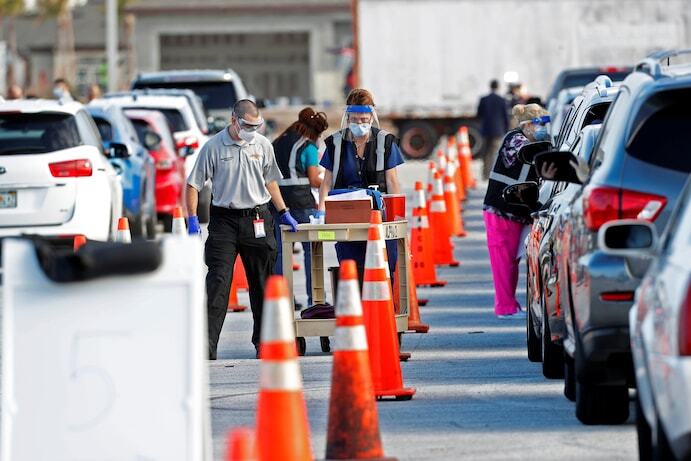 2020-12-31
2020-12-31Trump administration falls far short of vaccination goals as new virus variant looms
Logistical problems at the heart of the federal government’s faltering rollout of coronavirus vaccines came into sharper view Thursday as the Trump administration fell vastly short of its goal of delivering an initial shot to 20 million people by the end of December. On the final day of a bleak year, only about 2.8 million people had received the shot, according to the Centers for Disease Control and Prevention — the first of two doses needed to provide immunity to the virus. Around 14 million doses had been distributed as of Wednesday, according to Gustave Perna, chief operating officer of Operation Warp Speed, and a total of 20 million doses have been allocated. Though the figures are an underestimate — data collection on vaccinations has lagged — the doses administered so far represent just a small fraction of the ambitious targets outlined by officials from the administration’s Operation Warp Speed program in the fall. “We’d have liked to have seen it run smoothly and have 20 million doses in to people today, by the end of 2020, which was the projection,” Anthony S. Fauci, the government’s leading infectious-disease expert, said in an interview with NBC’s “Today” show on Thursday. “Obviously it didn’t happen, and that’s disappointing.” Nationwide, states and health-care providers continued to grapple with unpredictable timelines for when new vaccine shipments would arrive and in what quantities, while chronically underfunded public health departments struggled to muster the resources to carry out mass injections of front-line workers and vulnerable people. Fauci said that he hoped momentum for vaccinations would build in the first weeks of the new year and bring the country closer to its immunization goals. “But there really has to be more effort in the sense of resources for the locals, namely the states, the cities, the counties, the places where the vaccine is actually going into the arms of individuals,” he said. “We have to support the local groups, the states and the cities to help them get this task done, which is a very prodigious task.” Under the Trump administration’s plan, the federal government supplies vaccines to states but leaves it to state officials to prioritize residents, send doses to providers and get shots into people’s arms. The approach — as well as a litany of logistical problems — has caused a varied distribution effort. Local health departments and hospitals tasked with administering the vaccines have complained that they do not know when shipments will come or if they will receive additional resources, said Oscar Alleyne, and epidemiologist and chief of programs and services for the National Association of County and City Health Officials, which is made up of about 3,000 local health departments. “Some health departments have only received vaccines as recently as this week,” Alleyne told The Washington Post. “I had one health department that told me they had received their vaccines the day after Christmas.” Alleyne compared the communication concerns to those that cropped up during the H1N1 pandemic in 2009, when unclear guidance hampered efforts to get the population vaccinated. “It really boils down to ensuring a very transparent process,” Alleyne said. “There will always be a lag between the doses allocated and those shipped; between those shipped and those administered; and between those administered and those reported to CDC as administered,” Michael J. Pratt, a spokesperson for Operation Warp Speed, said in a statement. “We’re working to make those lags as small as possible.” At the Texas Medical Center, the largest medical complex in the world, the approach has already created logistical challenges. Hospital officials on the campus in south Houston often don’t know exactly when to expect new shipments or precisely how many vials they’ll receive, according to Bill McKeon, the center’s chief executive officer. That leaves the center with just a couple days’ worth of vaccine inventory on hand at a time, he said. “At best, we hear estimates. It’s a day-to-day situation,” McKeon told The Post. “We hear that we may be getting more next week but we’re not sure.” To date, the center has administered the first of the two injections to about 60,000 people, averaging more than 4,000 a day, according to McKeon. That includes some of the center’s 120,000 employees, as well as patients with underlying conditions who are first in line for inoculation. But it’s only a tiny portion of the sprawling metropolitan area the center serves. Until hospital officials can better predict how many vaccine doses they’ll have available week after week, McKeon said, vaccinating more people, faster, will be an uphill battle. “You can’t do scheduling with a couple days of inventory. We wouldn’t put a patient through the process of coming to the hospital, leaving their home, and then say, ‘Sorry we don’t have the inventory,’ ” he said. “We can’t be bold and just say, ‘Let’s do ten thousand a day.’ ” McKeon called on the federal government to take a more active role, possibly offering more large-scale vaccination centers, and relieve pressure on state officials, whom he said were “rowing in the same direction” as providers. There will be a growing need not just for more health-care workers to give the shots, he said, but for people who can perform the administrative work of calling patients, verifying their personal information and signing them up for injections. “I’m not seeing the grand strategies on a national basis, and I’m concerned, because this is a war,” he said. “Every day that we delay on some of those grander strategies we’re going to see losses of life.” As the distribution of vaccines has proceeded in fits and starts, coronavirus deaths and hospitalizations have soared to new heights. More than 125,000 people around the country were in hospital beds battling covid-19, the disease caused by the virus. Hospitalizations have exceeded 100,000 since Dec. 2. The nation on Wednesday also recorded a record 3,862 deaths in a day. The previous record, set on Dec. 17, was 3,406. New daily reported cases were trending upward again, after dipping during the week of Christmas. Family gatherings and spikes in holiday travel make it all but certain that the new year will bring yet another wave of infections. Compounding fears about the accelerating virus spread, a new, more transmissible variant of the coronavirus has cropped up in multiple U.S. states after circulating in the United Kingdom. The presence of the mutated pathogen only added to the need for vaccinations to ramp up quickly, said Scott Gottlieb, former Food and Drug Administration commissioner. “The Covid vaccine could be a tool to help reduce the impact of current wave of epidemic spread,” he tweeted Thursday. “But we’re largely missing the narrow window we had to deploy it rapidly enough to alter the present trajectory of death and disease in January. The new variant makes this more urgent.” Clarification: This story has been updated to cite Operation Warp Speed’s distribution numbers. It has also been updated to note that Operation Warp Speed has allocated 20 million vaccine doses to states. -
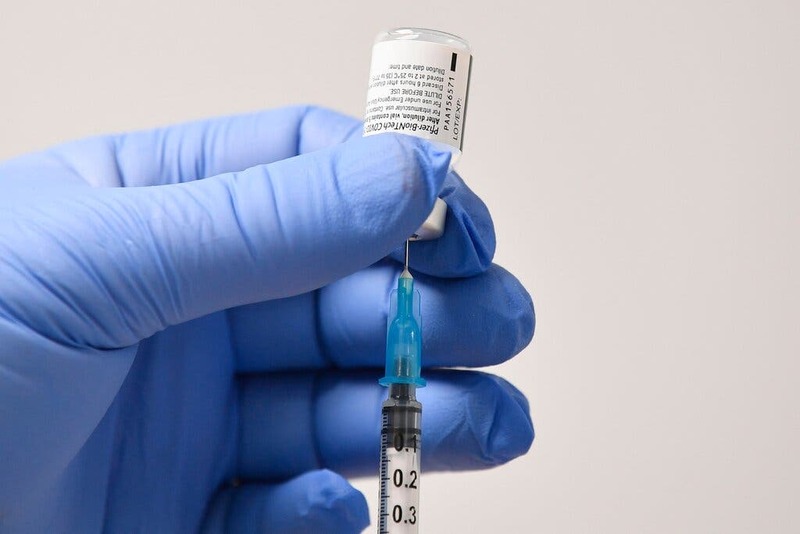 2020-12-14
2020-12-14The U.S. Approves a Vaccine
The Food and Drug Administration authorized Pfizer’s Covid-19 vaccine for emergency use on Friday, clearing the way for millions of highly vulnerable people to begin receiving inoculations within days. The authorization is a turning point in a pandemic that has taken more than 290,000 lives in the United States. With the decision, the United States becomes the sixth country — in addition to Britain, Bahrain, Canada, Saudi Arabia and Mexico — to clear the vaccine. Today, we ask the science and health reporter Donald G. McNeil Jr. what might happen next. -
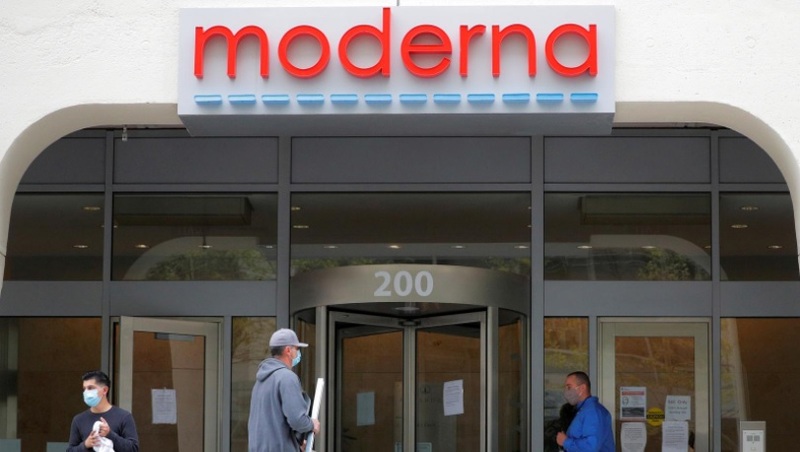 2020-07-14
2020-07-14Moderna Phase 1 results show coronavirus vaccine safe, induces immune response
Moderna Inc’s experimental vaccine for COVID-19 showed it was safe and provoked immune responses in all 45 healthy volunteers in an ongoing early-stage study, U.S. researchers reported on Tuesday. Volunteers who got two doses of the vaccine had high levels of virus-killing antibodies that exceeded the average levels seen in people who had recovered from COVID-19, the team reported in the New England Journal of Medicine. No study volunteers experienced a serious side effect, but more than half reported mild or moderate reactions such as fatigue, headache, chills, muscle aches or pain at the injection site. These were more likely to occur after the second dose and in people who got the highest dose. Experts say a vaccine is needed to put an end to the coronavirus pandemic that has sickened millions and caused nearly 575,000 deaths worldwide. Moderna was the first to start human testing of a vaccine for the novel coronavirus on March 16, 66 days after the genetic sequence of the virus was released. Dr. Anthony Fauci, director of the National Institute of Allergy and Infectious Diseases, whose researchers developed Moderna’s vaccine candidate, called the results “good news,” noting that the study found no serious adverse events and the vaccine produced “reasonably high” levels of virus-killing or neutralizing antibodies. “If your vaccine can induce a response comparable with natural infection, that’s a winner,” Fauci said in a telephone interview. “That’s why we’re very pleased by the results.” Moderna shares jumped more than 15% in after-hours trading on Tuesday. The U.S. government is supporting Moderna’s vaccine with nearly half a billion dollars and has chosen it as one of the first to enter large-scale human trials. A successful vaccine could be a turning point for Cambridge, Massachusetts-based Moderna, which has never had a licensed product. Moderna’s shot, mRNA-1273, uses ribonucleic acid (RNA) - a chemical messenger that contains instructions for making proteins. When injected into people, the vaccine instructs cells to make proteins that mimic the outer surface of the coronavirus, which the body recognizes as a foreign invader, and mounts an immune response against. The results released Tuesday involved three doses of the vaccine, tested in groups of 15 volunteers aged 18-55 who got two shots, 28 days apart. The groups tested 25, 100 or 250 micrograms of the vaccine. Adverse events after the second dose occurred in seven of the 13 volunteers who got the 25-microgram dose, all 15 participants who received the 100 microgram dose and all 14 who got the 250 microgram dose. In the highest-dose group, three patients had severe reactions such as fever, chills, headache or nausea. One of these had a fever of 103.28 Fahrenheit (39.6 C). “We didn’t see any events that are characterized as serious adverse events,” said lead author Dr Lisa Jackson of Kaiser Permanente Washington Health Research Institute in Seattle, referring to reactions that require hospitalization or result in death. In June, Moderna said it selected the 100-microgram dose for its late-stage study to minimize adverse reactions. At that dose, Moderna said the company is on track to deliver about 500 million doses per year, and possibly up to 1 billion doses per year, starting in 2021, from the company’s internal U.S. manufacturing site and strategic collaboration with Swiss drugmaker Lonza. “It’s a good first step,” said Dr William Schaffner, a vaccine expert at Vanderbilt University Medical Center who was not involved in the study. “There’s nothing here that would inhibit one from going ahead to the Phase 2/Phase 3 trials,” he said. In April, Moderna expanded the Phase 1 trial to include adults over 55, who are more at risk of serious disease, with the aim of enrolling 120 volunteers. Moderna said it will follow study volunteers for a year to look for side effects and check how long immunity lasts. Moderna started its phase 2 trial in May and expects to start a phase 3 trial on July 27. Phase 1 trials aim to ensure a treatment is safe and help determine an effective dose. Phase 2 trials test a treatment in a larger group and get an early read on effectiveness. Phase 3 trials are conducted in a large group of individuals to confirm efficacy and identify rare side effects. Moderna’s Phase 3 trial will be conducted in 30,000 volunteers. -
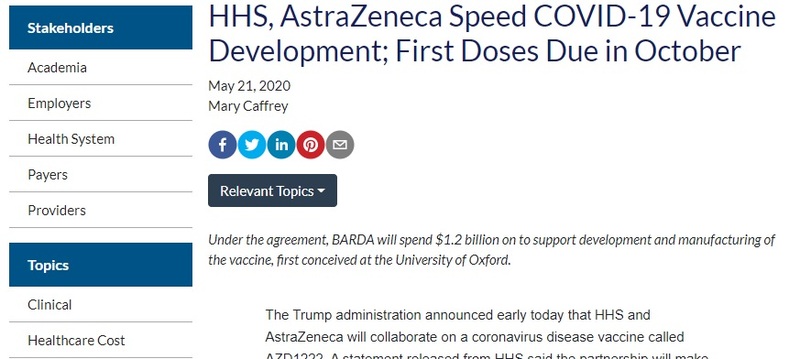 2020-05-21
2020-05-21HHS, AstraZeneca Speed COVID-19 Vaccine Development; First Doses Due in October
The Trump administration announced early today that HHS and AstraZeneca will collaborate on a coronavirus disease vaccine called AZD1222. A statement released from HHS said the partnership will make “at least 300 million doses” of the vaccine available, “with the first doses delivered as early as October 2020.” The vaccine is one originally developed at the University of Oxford; the university and AstraZeneca announced a global development agreement for the vaccine on April 30. In its own statement early today, AstraZeneca said a phase 1/2 clinical trial of the vaccine began last month to assess its safety immunogenicity and efficacy in over 1000 healthy volunteers, who are 18 to 55 years of age. These volunteers are all in the United Kingdom. Late-stage trials would begin in several countries based on these results, the statement said. According to HHS, the agreement between AstraZeneca and the Biomedical Advanced Research and Development Authority (BARDA), an agency within HHS, would essentially kick start manufacturing of the doses while phase 3 clinical studies are under way this summer, involving 30,000 volunteers in the United States. BARDA will spend up to $1.2 billion for research, technology transfer, and scaled-up manufacturing, Emergency use authorization or licensure from FDA would be needed for the vaccine to reach the public, the statement said. As for the timeline, “Early milestones enable BARDA and AstraZeneca to determine how the program progresses forward.” “This contract with AstraZeneca is a major milestone in Operation Warp Speed’s work toward a safe, effective, widely available vaccine by 2021,” said HHS Secretary Alex Azar. “Getting a vaccine to the American public as soon as possible is one part of President Trump’s multi-faceted strategy for safely reopening our country and bringing life back to normal, which is essential to Americans’ physical and mental well-being in so many ways.” “The Trump Administration is making multiple major investments in developing and manufacturing promising vaccines long before they’re approved so that a successful vaccine will reach the American people without a day wasted,” Azar said. Besides the BARDA agreement, AstraZeneca said it has reached deals with the Coalition for Epidemic Preparedness Innovations (CEPI), the Vaccine Alliance and the World Health Organisation (WHO), to ensure the fair allocation and distribution of the vaccine around the world. AstraZeneca is also in discussions the Serum Institute of India and other potential partners to boost production and distribution. AstraZeneca also holds a major stake in Moderna Therapeutics, which announced earlier this week its experimental vaccine had produced antibodies in small group of healthy volunteers. -
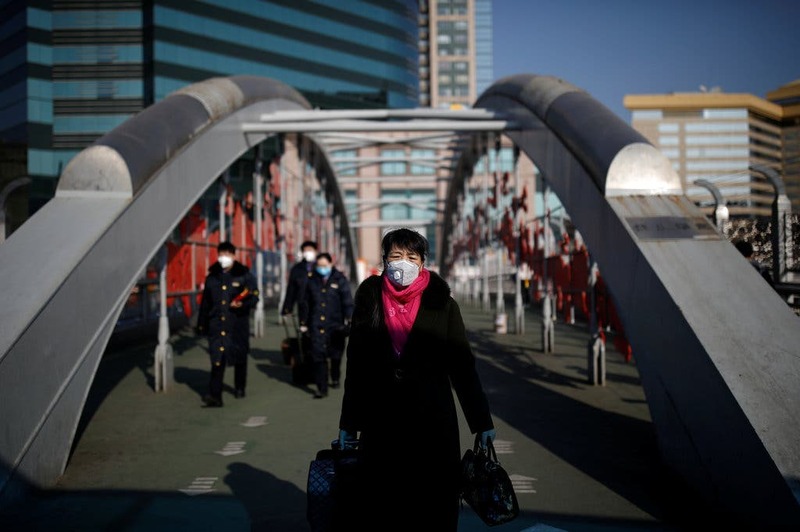 2020-01-30
2020-01-30WHO Declares Coronavirus a Global Public Health Emergency
The World Health Organization declared a global health emergency on Thursday as the coronavirus outbreak spread well beyond China, where it emerged last month. The move reversed the organization’s decision just a week ago to hold off such a declaration. Since then, there have been thousands of new cases in China and clear evidence of human-to-human transmission in several other countries, including the United States. -
2021-11-02
COVID-19 Pandemic
The text story would be about my feelings toward COVID-19. It is sad that I don't remember much of what life was like before the pandemic hit. The masks, the social distancing, the looks you get when you have a runny nose. There are so many theories in regards to COVID-19 and much like anything else, everyone has their own opinion. Some revolve their lives around it, others don't care about. Personally, I'm not scared of the pandemic, I'm not vaccinated, nor do I get worried when people around me test positive for it. It is important to me because it has significantly changed our lives for the worse. We miss out on extremely important events and experiences. In my opinion, much of this should be a choice. If you want to wear a mask, wear one. If you want to social distance, do it. If you want to get vaccinated, get vaccinated. -
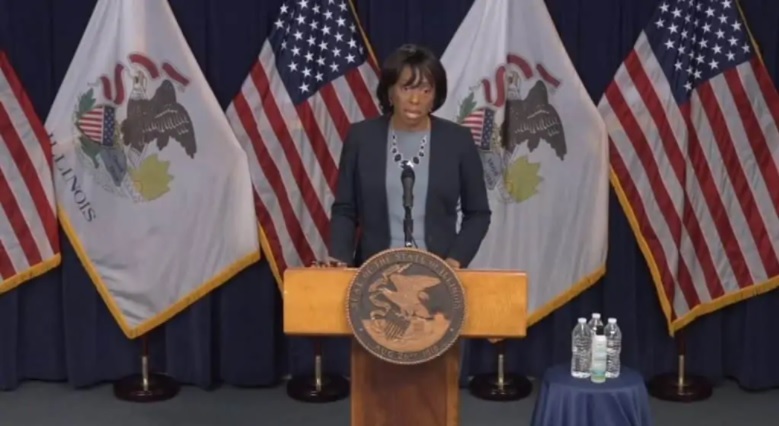 2021-10-31
2021-10-31Health officials push for booster shots as 50% of last week’s COVID-19 deaths in Illinois were breakthrough cases
Health officials are pushing residents to get booster shots as state data shows about 50% of the recorded COVID deaths in Illinois last week were cases where people were fully vaccinated. The Illinois Department of Public Health (IDPH) reported there were 179 COVID-19 deaths from October 20 to October 27. From the same reporting period of October 20-27, there were 91 breakthrough cases, IDPH data shows. A breakthrough case is when a person tests positive for COVID-19 at least 14 days after being fully vaccinated and did not test positive in the previous 45 days, according to IDPH. 87% of all breakthrough COVID-19 deaths in Illinois have been in the 65+ age group. Illinois Department of Public Health spokeswoman Melaney Arnold told Lake and McHenry County Scanner that COVID-19 vaccines “continue to be highly effective at preventing death due to COVID-19.” [Suggested Article] Illinois attorney general, 51 other attorneys general call on Congress to protect children on Facebook, Instagram “Of the more than 7 million people in Illinois who are fully vaccinated, breakthrough deaths have occurred in 0.01% of the population,” Arnold said. Arnold noted that not all breakthrough deaths reported from October 20 to October 27 actually occurred in that span. “It takes time (days to weeks) to match death records with vaccination records; therefore; there can be a lag in when the death occurred and when it is reported as a breakthrough death,” she said. Still, the reporting week from October 20 to October 27 had the highest percent of breakthrough deaths compared to non-breakthrough deaths since the state began publishing the data back in April. Currently, Illinois residents 65 or older, anyone 18+ with underlying medical conditions or who work or live in high-risk settings, such as educators and first responders, are eligible to receive a booster shot of the Pfizer and Moderna vaccines. Those who received the Johnson and Johnson vaccine are able to get any COVID-19 vaccine as their booster shot, the CDC says. “We know that advanced age is a significant factor in COVID-19 breakthrough hospitalizations and deaths, but a booster dose can help provide continued protection,” IDPH Director Dr. Ngozi Ezike said earlier this month. “While COVID-19 vaccines continue to be effective in reducing the risk of severe disease, hospitalization, and death, scientists and medical experts continue to watch for signs of waning immunity, how well the vaccines protect against variants, and how that data differs across age groups and risk factors,” Ezike said. -
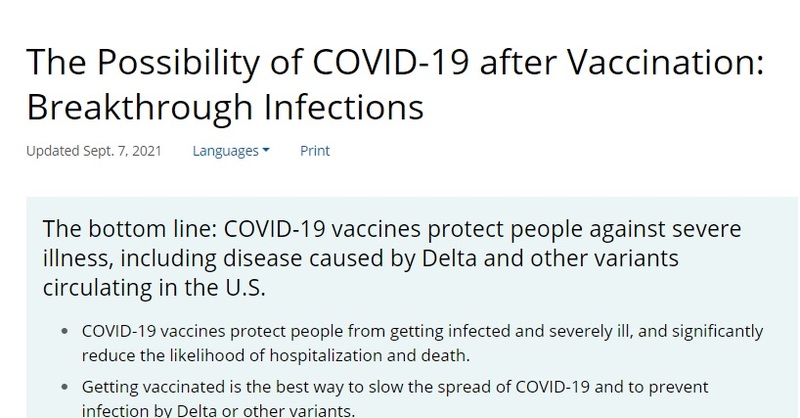 2021-09-07
2021-09-07The Possibility of COVID-19 after Vaccination: Breakthrough Infections
COVID-19 vaccines are effective at preventing infection, serious illness, and death. Most people who get COVID-19 are unvaccinated. However, since vaccines are not 100% effective at preventing infection, some people who are fully vaccinated will still get COVID-19. An infection of a fully vaccinated person is referred to as a “vaccine breakthrough infection.” -
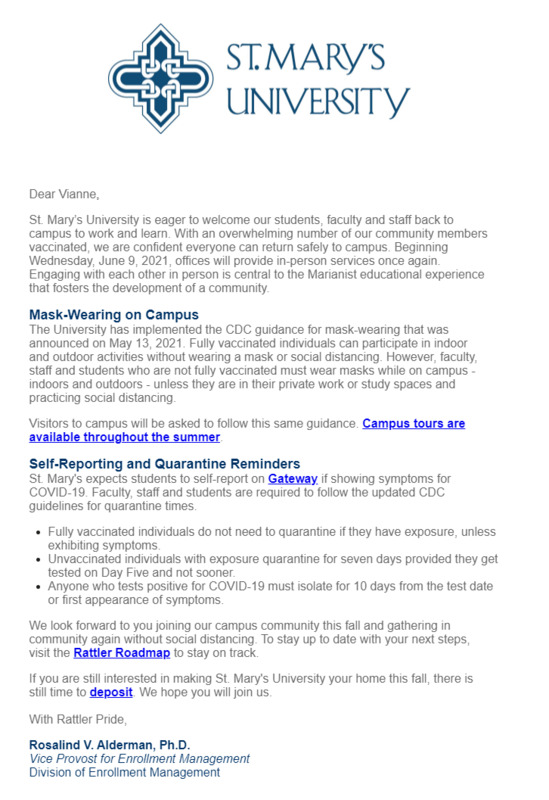 2021-06-08
2021-06-08Back To "Normal"
With the distribution of the vaccine everyone thought things were going back to normal. The pandemic seemed like it was coming to a close. Institutions were beginning to lift the indoor mask-wearing requirements for vaccinated individuals per the CDC's announcement. St Mary's University was one of these of these places. Unfortunately with the rise of the Delta variant St. Mary's had to revoke their decision regarding masks a few weeks later. It was back to "normal" mask-wearing policies no matter what your vaccination status. I, like many others, was disappointed by masks being required again. Too often I had been made late by trying to find a mask to take or even running back to my house or car because I forgot mine. Or ran embarrassed out of a store because I forgot to wear one the entire time I was shopping. I also missed putting on makeup below my eyes, a ritual that helped me feel more put together. They're simple, silly reasons for not wanting to wear a mask anymore but to me they represented normalcy. -
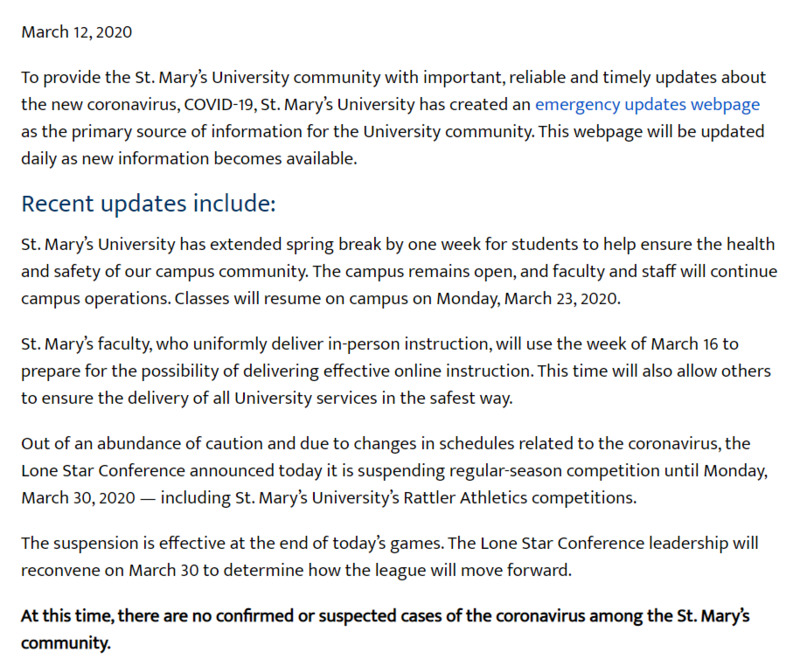 2020-03-12
2020-03-12A Permanent Break
This image shows how much almost everyone underestimated the pandemic. It also highlights the uncertainty it brought. Most thought we were just getting one extra week of staying home. We would be heading back to campus after that so we were grateful for the extra vacation time. Little did we know that there would be no end in sight for this pandemic for almost two years. No one knew how long it would last or exactly how much it would affect our everyday lives. Procedures constantly changed as institutions tried to figure out the best way to respond to this unprecedented situation. I think this image would spark student memories of the reaction they had to similar school announcements. Many people were on vacation and came home to a total shift in society like panic buying. My family was in Mexico at the time and in the middle of the vacation the hotel switched from open buffet and people roaming to encouraging people not to interact with others. Before my family left my stepdad had bought some nonperishables to store. I didn't know why he did this and thought this was silly and just a habit from his Red Cross responder days. It turns out he was correct in predicting people would flock to the stores once institutions started practicing preventive measures. This image is just one of the many that demonstrate how people's lives began to change during this time. -
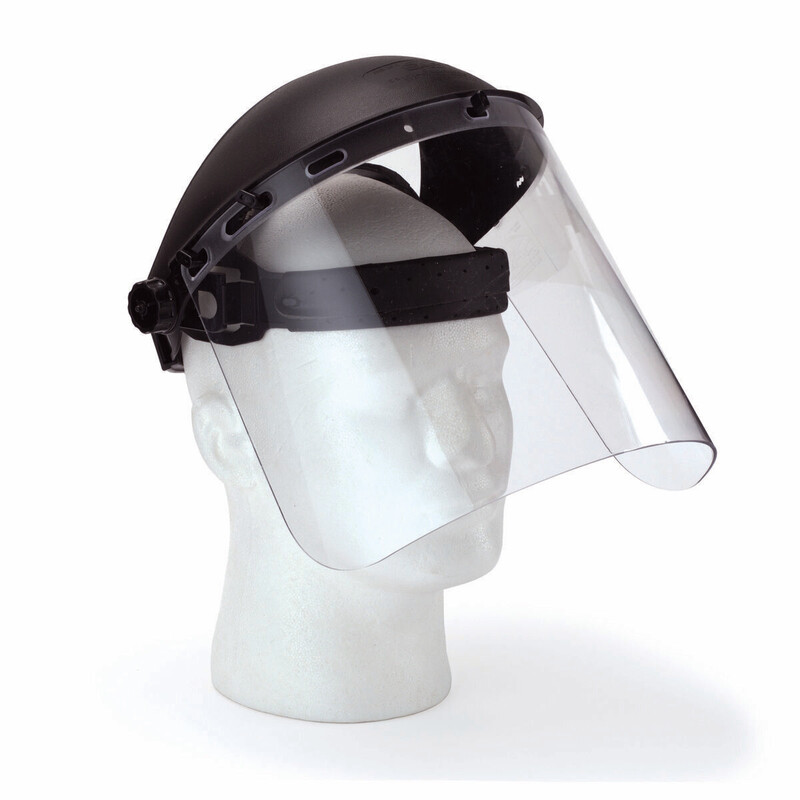 2021-10-14T19:40
2021-10-14T19:40The Clonky Helmet
I personally worked as a COVID 19 screener for South Texas Veterans Affairs. During that time we as COVID screeners were required to wear face shields and masks on our face for more than eight hours a day. After reading the article I posted from the CDC -- it now does not seem like it was a requirement at all for health workers to wear the face shields. I preferred to wear the ones that were much lighter. They were also face shields, but they were not in a shape of a helmet, they were lighter, and easier to handle as we screeners went from one job station to another. During the pandemic, while employed as a COVID 19 screener-- if we were caught without wearing the helmet (face shield) our jobs were threatened. We were only allowed to take the face shields off intermittently, for example, while at lunch. -
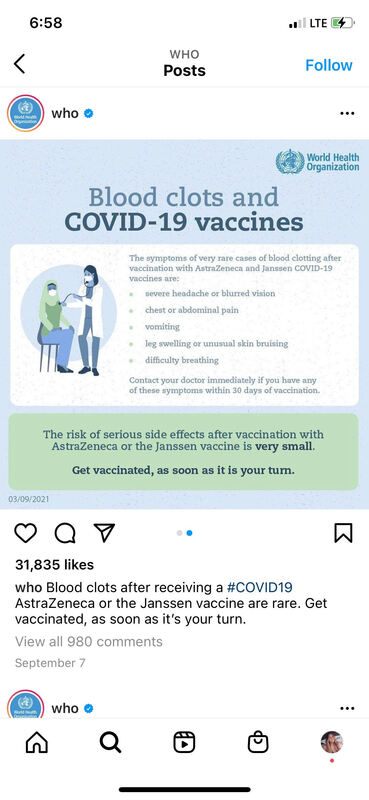 2021-09-07
2021-09-07Thoughts on Covid-19 Vaccine and Blood Clots: Social Media Screenshot
As someone who has studied the history of disease and epidemics, I know that disease causes widespread fear and panic. The uncertainties and unknowns of disease cause people to question themselves, others, and even medical professionals. Sometimes, questioning and being skeptical is what saved lives. For example, questioning Dr. Rush's treatment methods in the yellow fever epidemic of Philadelphia or questioning miasma theory during the outbreaks of cholera in London. Recently, there have been cases of blood clots as a result of the Covid-19 vaccine. This is a screenshot of what WHO has to say about the blood clots and a comment from myself. While I would love to get the vaccine, and I was originally hopeful about getting it, I'm not too scared and unsure what to do. Although WHO says cases of blood clots are rare, there are still many people like myself who are skeptical and only want to make the right decision for their own health and life. With talk of possible mandated vaccines, I am uncertain about what the future will look like for me and others like me. -
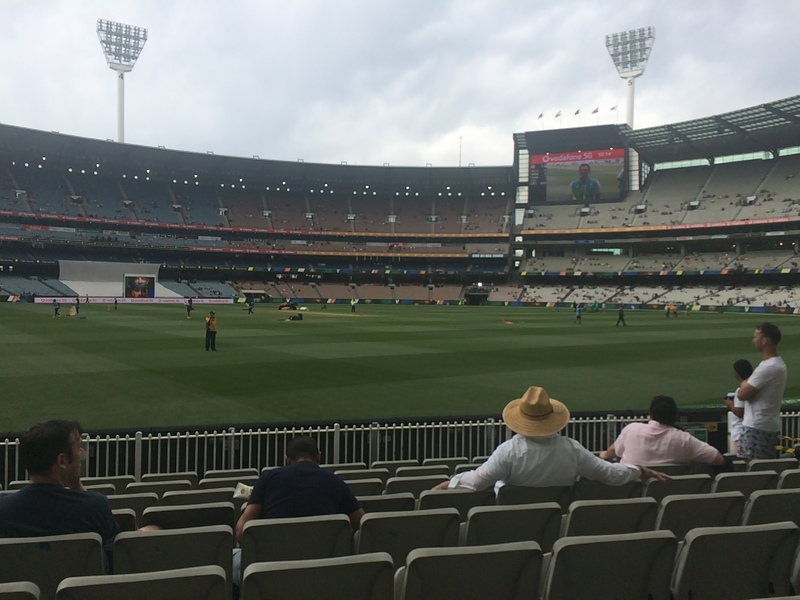 2020-12-27
2020-12-27Boxing Day Test at the Melbourne Cricket Grounds
Despite most activities being cancelled due to restrictions, I was lucky enough to score four free tickets to the Boxing Day Test cricket match in Melbourne at the MCG, and I brought three of my friends to the match. It was actually my first time at a live sporting event, so it was particularly memorable for me. Rather scarily, we soon found out a few days later that one of the spectators on that day would later test positive for COVID-19, leading me to take a COVID test myself, which thankfully turned out to be negative. -
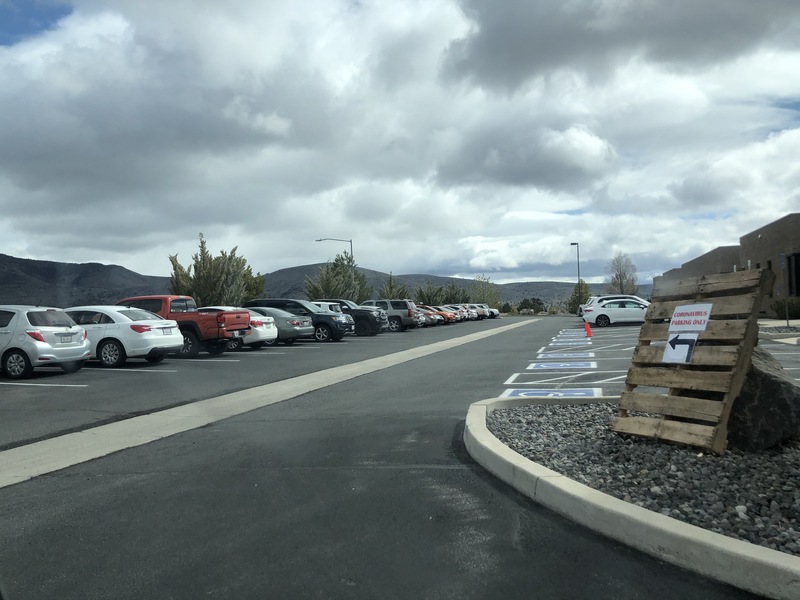 2020-03-30
2020-03-30Covid Parking
I had a friend that kept telling me that the pandemic was fake. I told her that we needed to take it serious. When I took my daughter to the local urgent care for a doctors appointment, this was the parking lot scene. I just remember being blown away at the seriousness of the situation. The urgent care separated even those that came in for covid testing from the other patients, just to keep things extra safe. -
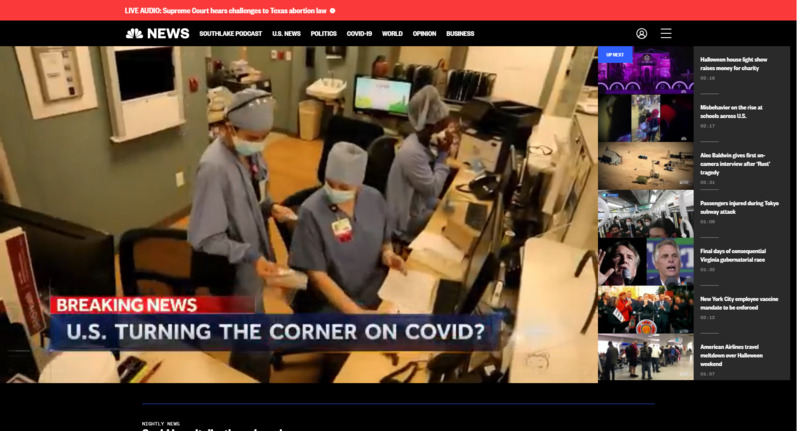 2021-10-06
2021-10-06Covid Hospitalizations Drop Nationwide
As of September 1st, Covid-19 cases are dropping nationwide. Even though there are still hot spots across the United States, cases have dropped nearly fifty percent. -
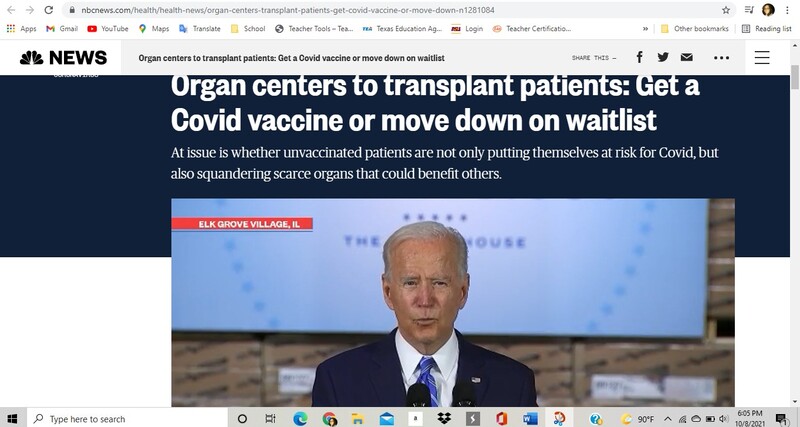 2021-10-08
2021-10-08Organ Transplant Debate: Get Vaccinated or Move Down the List
This article discusses the debate between patients who are unvaccinated and those who are vaccinated. Should it be a requirement for a transplant patient to get the vaccine? Being unvaccinated puts not only the patient at-risk for contracting COVID-19, but it exposes doctors, nurses, and other patients as well. Several states have already made it a requirement to get the vaccine before being placed on the organ transplant list. -
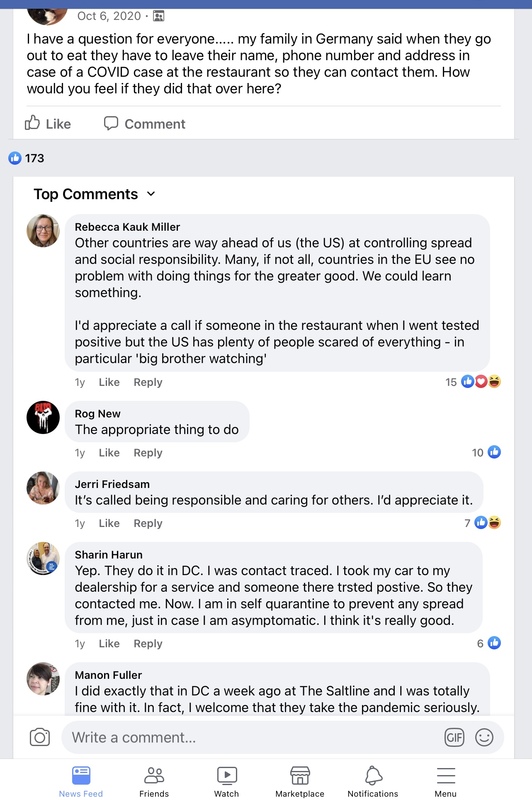 2020
2020International Discussion
This conversation was interesting to me because it is an example of how the internet has been able to give people an idea of what the pandemic has been like in other parts of the world. It also presents a strategy some leadership enacted to control the spread of the virus. -
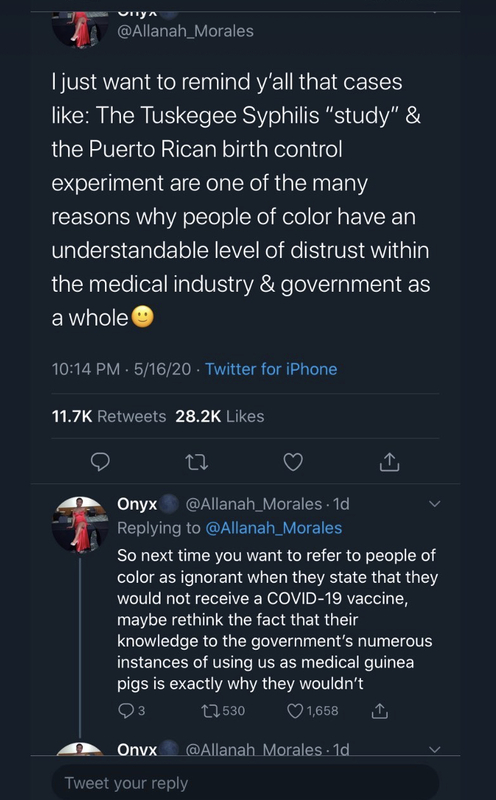 2021-05-16
2021-05-16Vaccine Hesitancy in the Black Community
This tweet reflects an ongoing controversy of the Covid-19 vaccine. The media has reported a hesitancy of the mRNA vaccine amongst the black community, but with little to no context on why there is such hesitancy. Based on the history of the U.S. public health institution, there have been reported inequalities that include a racial hierarchy within the medical system. This tweet specifies the instances of medical malpractice committed towards people of color and insists on an understanding of racial inequality through the lens of people of color that led to skeptical feelings about the vaccine. -
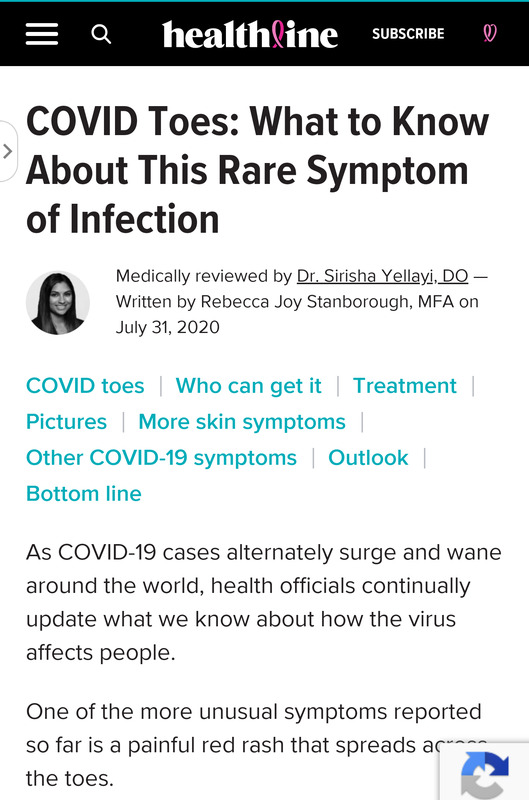 -2021-10-08
-2021-10-08Covid Health Effects
My co-workers in EMS have described to me the spectrum of symptoms they have seen from Covid 911 calls. The 'Covid toe' is one of the most perplexing symptoms of the disease, along with long-term health consequences from the virus. The unpredictability of symptoms is one of the virus' strange hallmarks. -
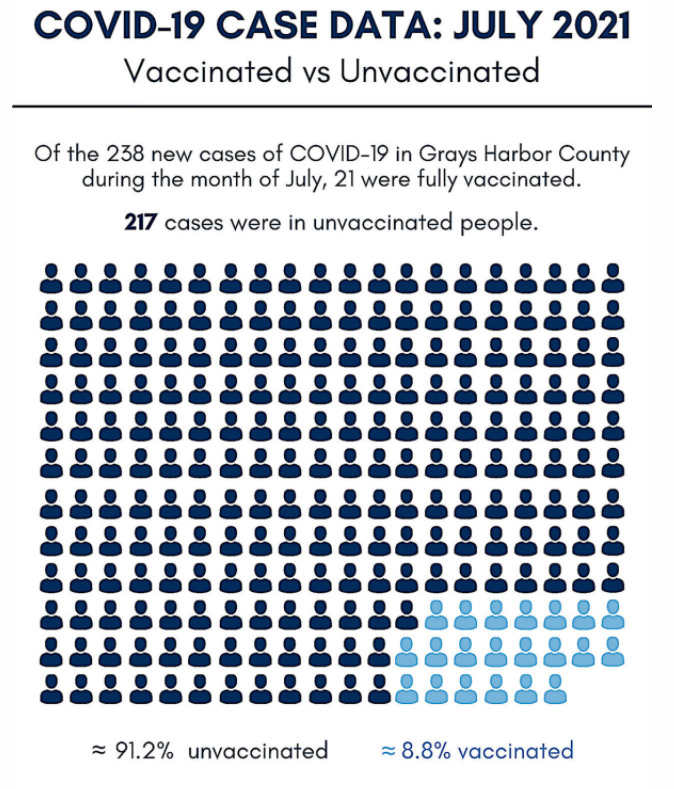 2021-08-17
2021-08-17Vaccine Rates and Covid in Gray's Harbor County
Grays Harbor County is having a Covid spike that is mainly affecting the unvaccinated population. This is adding stress to the testing facilities in the county and causing issues with hospitalizations. -
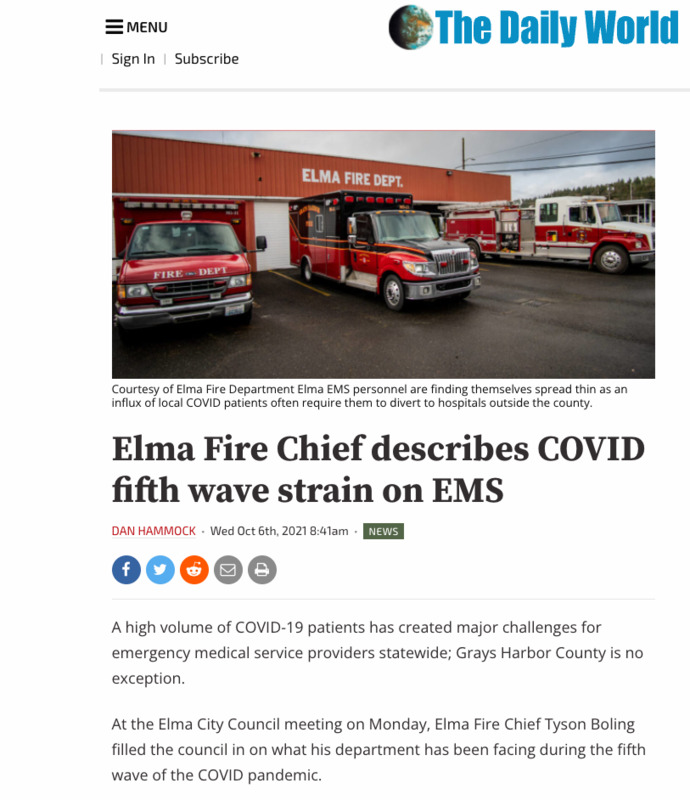 2021-10-06
2021-10-06The Fifth Wave and it's Strain on a Small Costal Town
The coastal town of Elma, Washington has been hit hard by Covid. The smaller-sized hospitals are overrun with Covid patients and the burden being put on healthcare infrastructure in the area is massive. People are having to wait hours for care at local hospitals and chances are if you call an ambulance, it will not be able to take you to a local hospital. The extra driving is eating up the EMS system's time and causing issues with getting care from emergency services. -
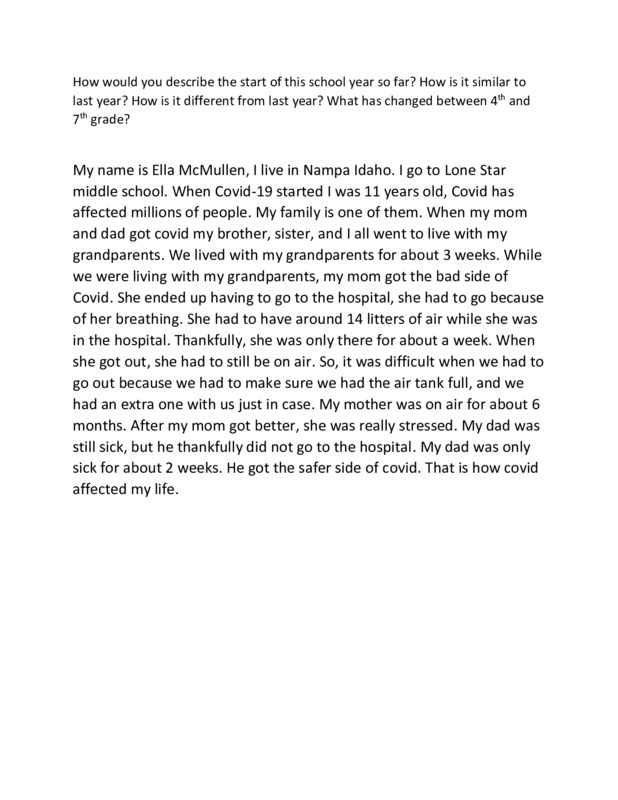 2021-10-08
2021-10-08My covied-19 experience: Ella McMullen
My name is Ella McMullen, I live in Nampa Idaho. I go to Lone Star middle school. When Covied-19 started I was 11 years old, Covied has affected millions of people. My family is one of them. When my mom and dad got covied my brother, sister, and I all went to live with my grandparents. We lived with my grandparents for about 3 weeks. While we were living with my grandparents, my mom got the bad side of Covied. She ended up having to go to the hospital, she had to go because of her breathing. She had to have around 14 litters of air while she was in the hospital. Thankfully, she was only there for about a week. When she got out, she had to still be on air. So, it was difficult when we had to go out because we had to make sure we had the air tank full, and we had an extra one with us just in case. My mother was on air for about 6 months. After my mom got better, she was really stressed. My dad was still sick, but he thankfully did not go to the hospital. My dad was only sick for about 2 weeks. He got the safer side of covied. That is how covied affected my life. -
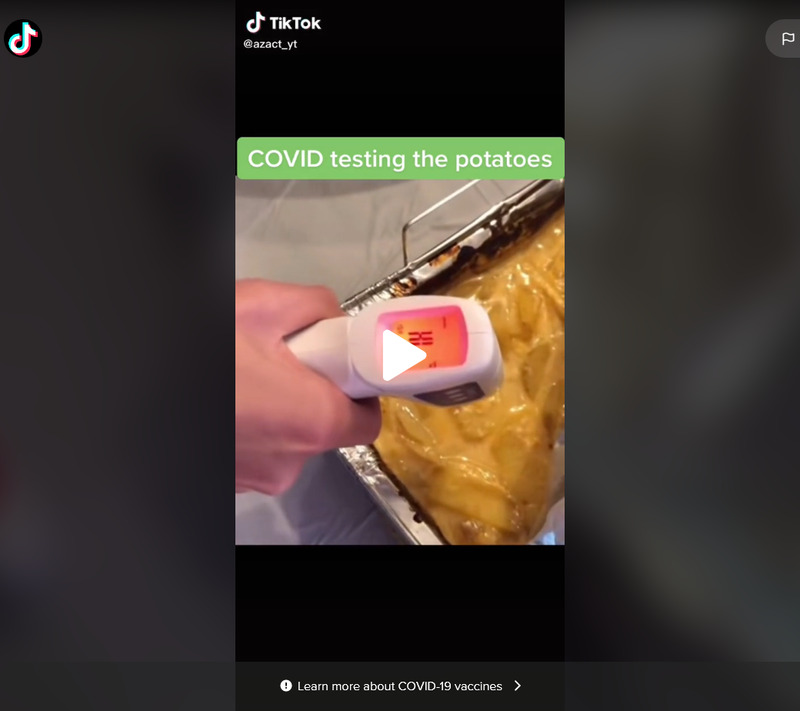 2021-07-06
2021-07-06Covid Testing the Potatoes
Humor with temperature testing during Covid-19 pandemic. -
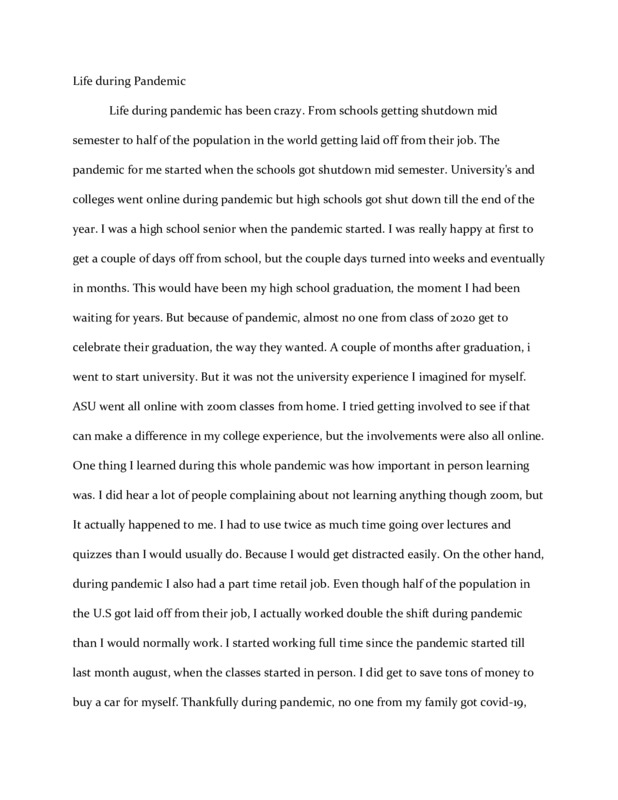 2020-03-19
2020-03-19Life during Pandemic
Life during pandemic has been crazy. From schools getting shutdown mid semester to half of the population in the world getting laid off from their job. The pandemic for me started when the schools got shutdown mid semester. University's and colleges went online during pandemic but high schools got shut down till the end of the year. I was a high school senior when the pandemic started. I was really happy at first to get a couple of days off from school, but the couple days turned into weeks and eventually in months. This would have been my high school graduation, the moment I had been waiting for years. But because of pandemic, almost no one from class of 2020 get to celebrate their graduation, the way they wanted. A couple of months after graduation, i went to start university. But it was not the university experience I imagined for myself. ASU went all online with zoom classes from home. I tried getting involved to see if that can make a difference in my college experience, but the involvements were also all online. One thing I learned during this whole pandemic was how important in person learning was. I did hear a lot of people complaining about not learning anything though zoom, but It actually happened to me. I had to use twice as much time going over lectures and quizzes than I would usually do. Because I would get distracted easily. On the other hand, during pandemic I also had a part time retail job. Even though half of the population in the U.S got laid off from their job, I actually worked double the shift during pandemic than I would normally work. I started working full time since the pandemic started till last month august, when the classes started in person. I did get to save tons of money to buy a car for myself. Thankfully during pandemic, no one from my family got covid-19, and we were all really safe. Overall, the pandemic was a crazy yet really wonderful experience for me because I not only learned importance of small things in our lives but also learned to always stay in touch with our family member and friends because you never know what will happen next. -
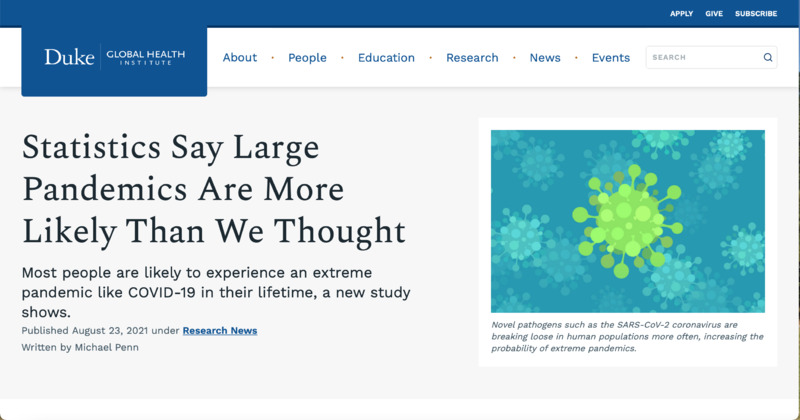 2021-08-23
2021-08-23Just when you thought it was safe...
This is an article from Duke Global Health Institute that theorizes that pandemics such as the one we are in now, are actually relatively common and most people are likely to experience one in their lifetime. -
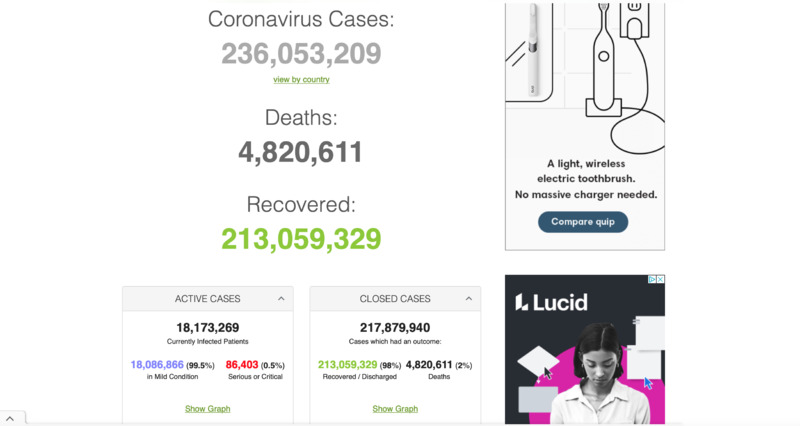 2021-10-04
2021-10-04Worldwide Statistics
While researching pandemic memes, I came across this website that compiles statistics on the pandemic from all around the world.
